Chart Indicators
Instructions
To apply chart indicators
-
From within a chart select the Edit menu and then select Studies.
-
Choose a study from the available studies section and click Add to add the study to the Applied Studies group.
-
Complete parameters as necessary.
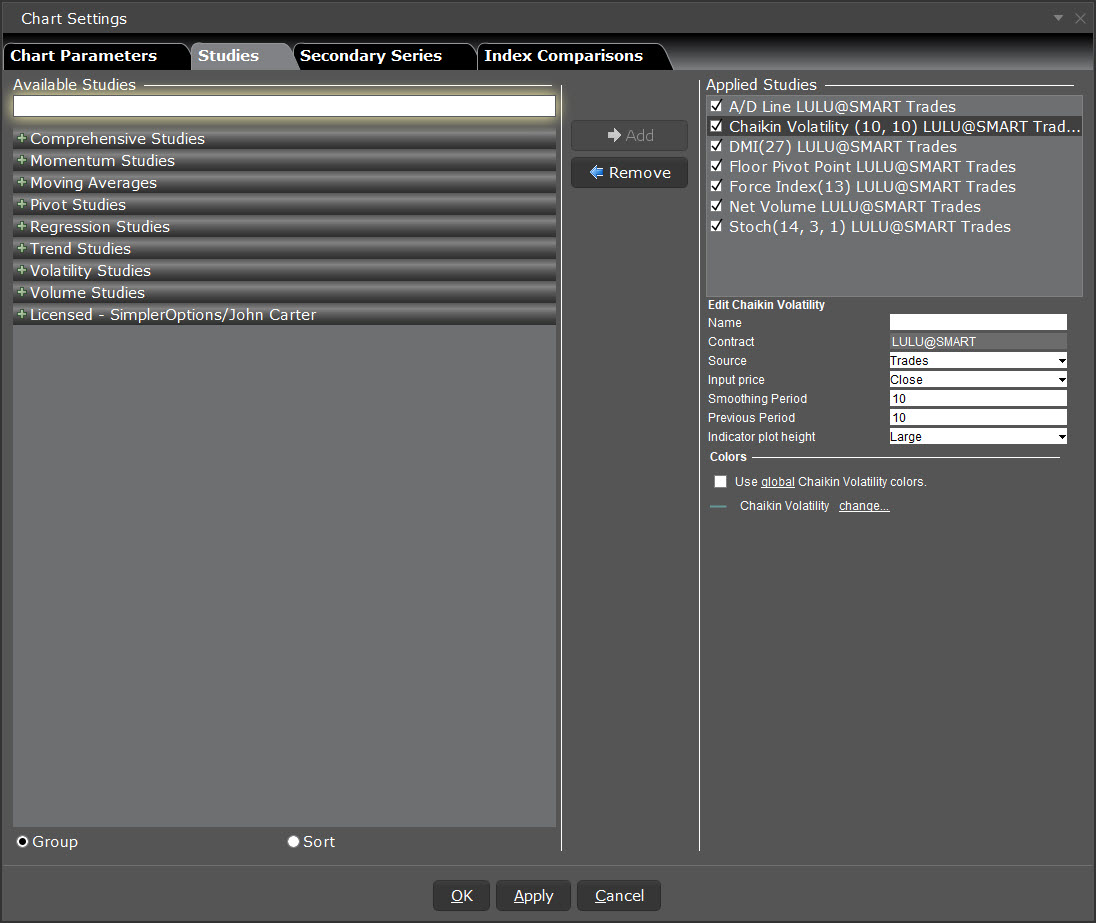
Once the study is defined, you can elect to uncheck / check to remove and add the study to your chart.
| Field | Description | Screenshot |
|---|---|---|
| Comprehensive Studies | ||
| Correlation Coefficient |
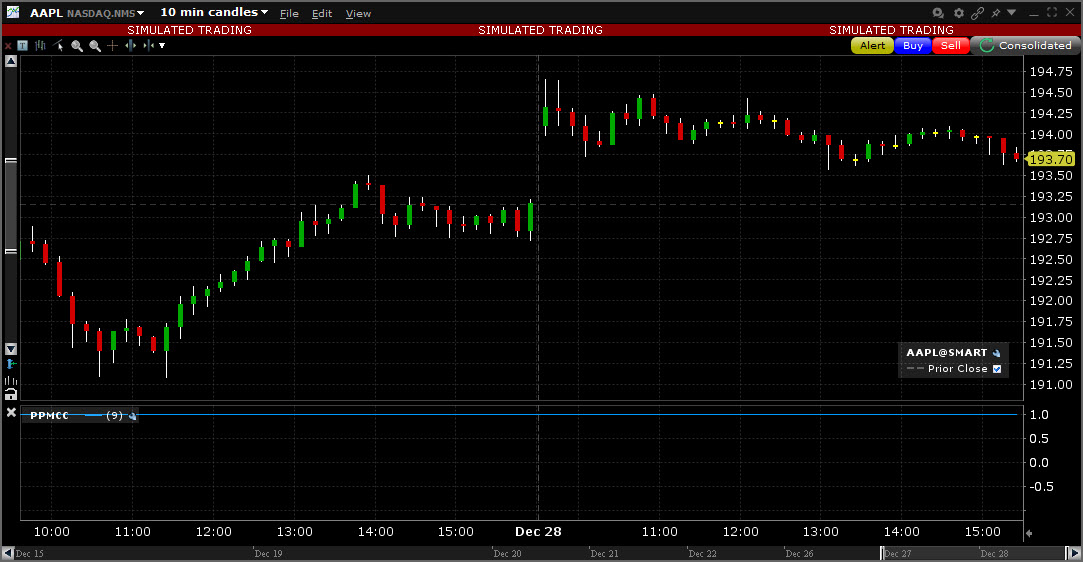
|
|
| Ichimoku Clouds | The Ichimoku Cloud indicator shows support and resistance, and momentum and trend directions. The "cloud" comprises five lines, and is formed between the spans of the conversion and baseline moving averages and the midpoint of the 52-week high and low. |
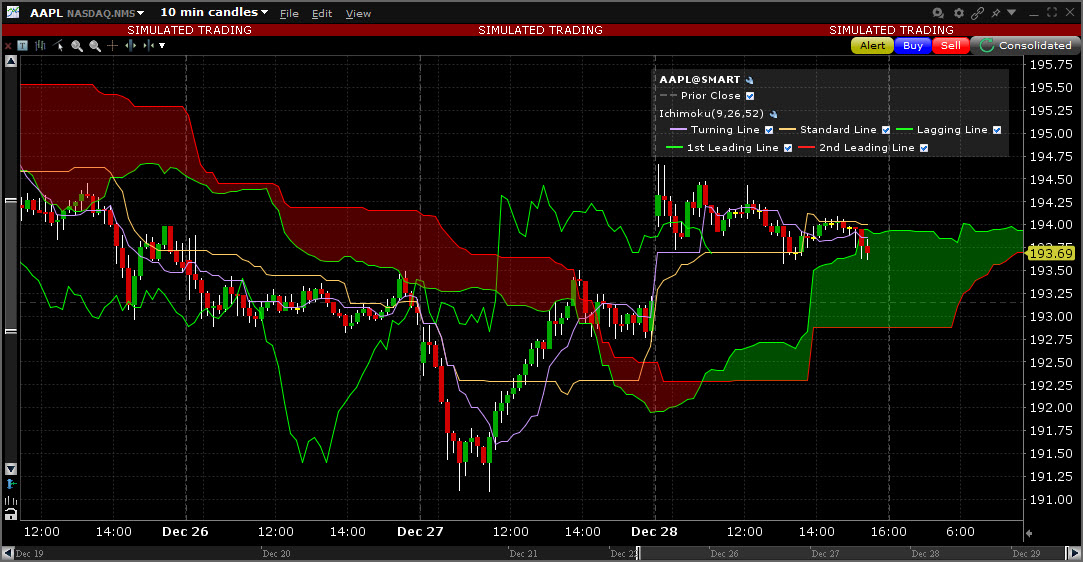
|
| Zig Zag | The Zig Zag is a series of trendlines that connect the tops and bottoms of significant prices. Connection criteria is defined using the indicator's Minimum Change or Percent Change parameter. |

|
| Momentum Studies | ||
| Accelerator/Decelerator | The Accelerator/Decelerator Technical Indicator (AC) measures acceleration and deceleration of the current driving force. This indicator will change direction before any changes in the driving force, which, in its turn, will change its direction before the price. The Acceleration/Deceleration is an early warning signal. |
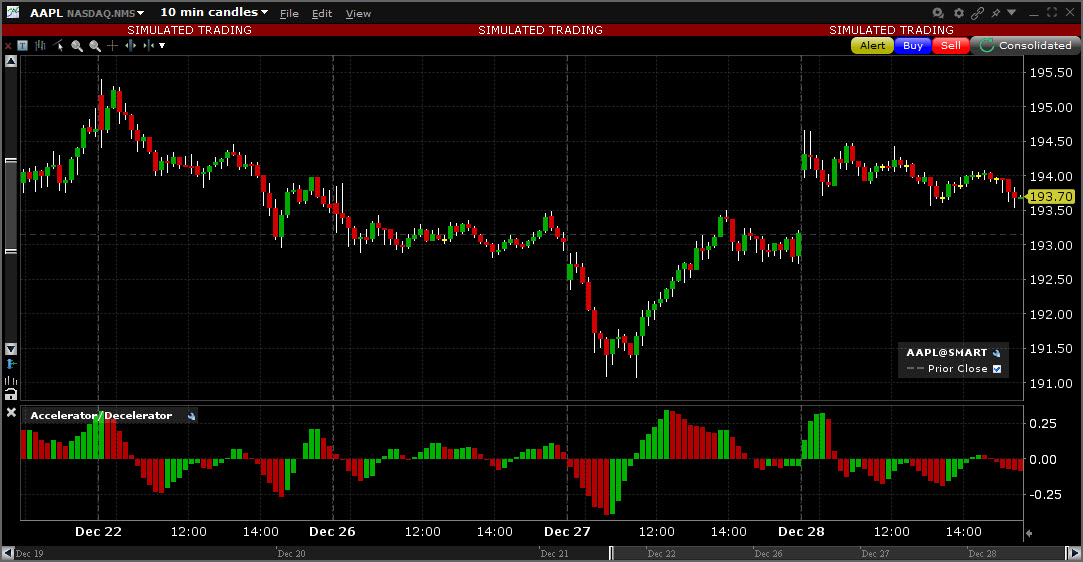
|
| Accumulation Swing Index |
The Accumulation Swing Index is a cumulative total of the Swing Index and attempts to show the phantom line which represents the “real market,” which theoretically occurs among the open, high, low and close prices. Since the Accumulation Swing Index attempts to show the "real market," it closely resembles the prices themselves. This allows you to use classic support/resistance analysis on the Index itself. Typical analysis involves looking for breakouts, new highs and lows, and divergences. |
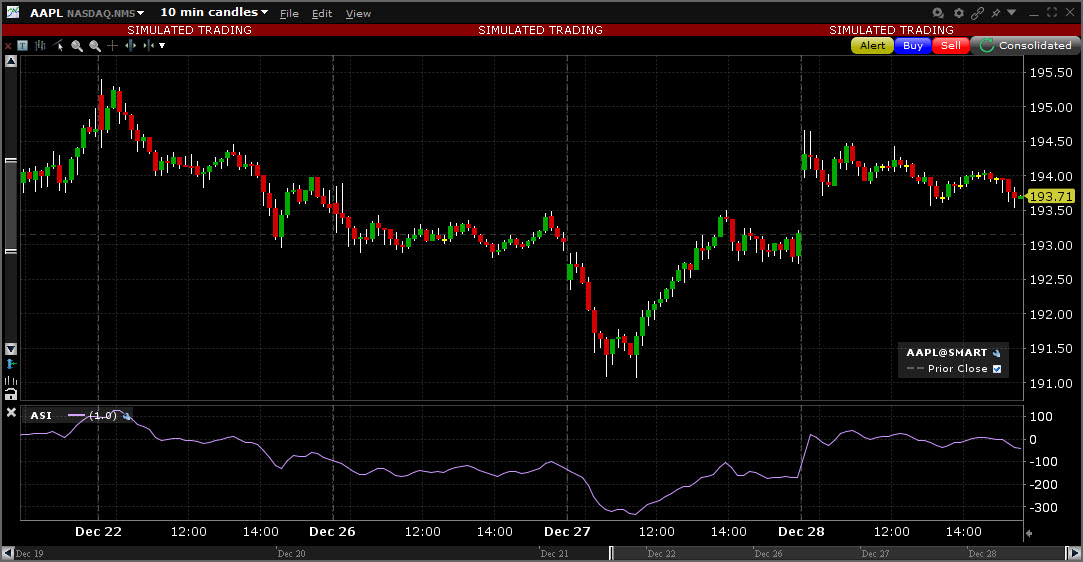
|
| Accumulation/Distribution | This indicator attempts to quantify the flow of money into and out of a given stock. In theory, knowing this money/volume flow may help you to recognize an upcoming move in the stock price. |
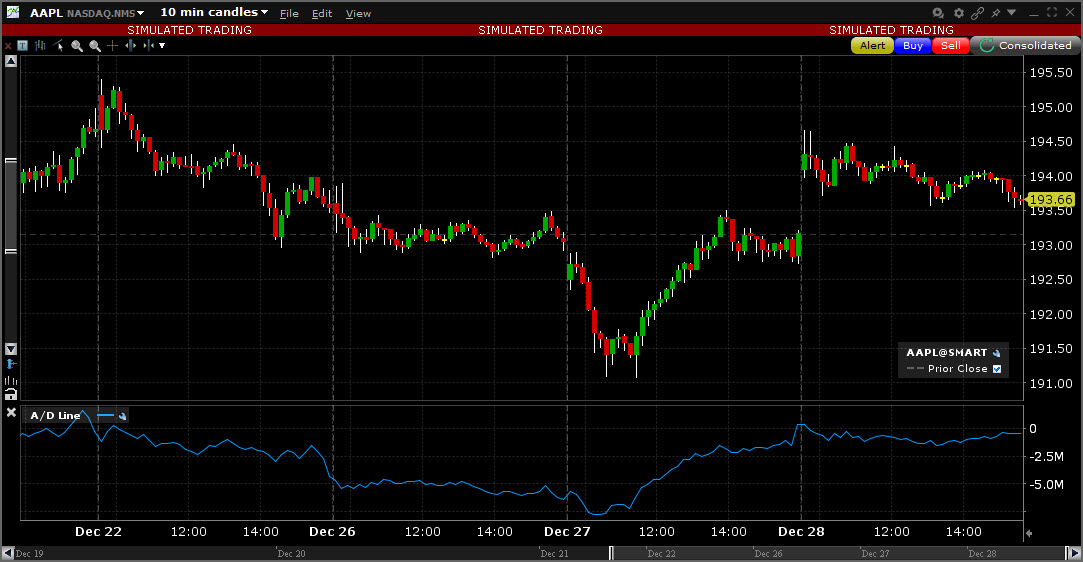
|
| Chaikin Money Flow | The Chaikin Money Flow Oscillator is calculated using the Accumulation/Distribution Line. It takes the cumulative total of the Accumulation/Distribution values for 21 periods (or X number of periods if you elect to change this value) divided by the cumulative total of volume for 21 (or X) periods. |
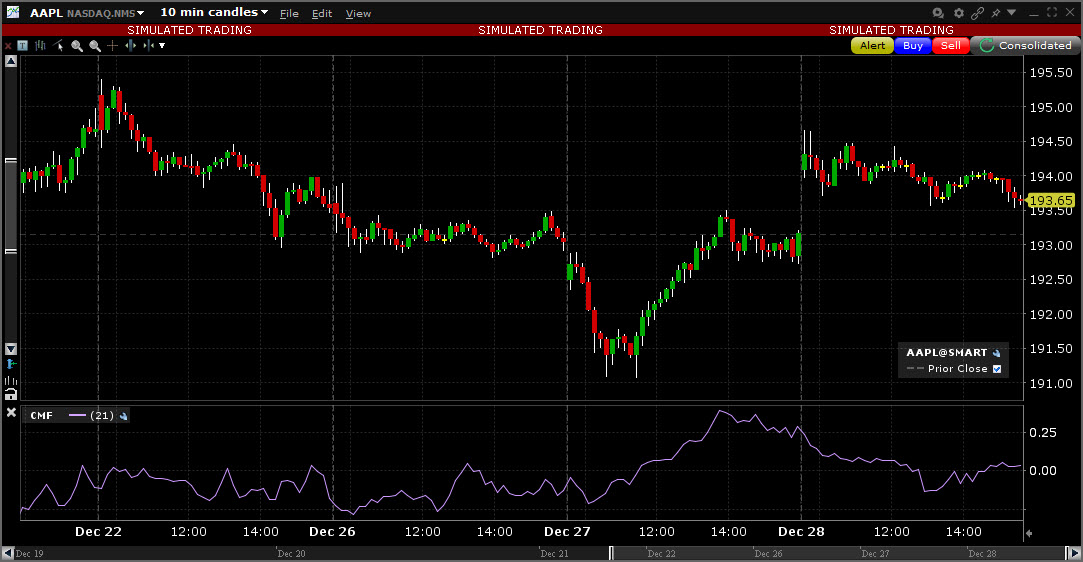
|
| Chaikin Oscillator |
The Chaikin Oscillator monitors the flow of money in and out of the market. It calculates and plots the difference between the 10-period exponential moving average and the three-period exponential moving average of the accumulation distribution. The accumulation distribution uses the relationship between the open and the close of the bar and the range of the bar to weigh and characterize the volume as accumulation (buying) or distribution (selling). In short, the Chaikin Oscillator compares the money flow to the price action of an issue, which allows the user to recognize tops and bottoms in short cycles. |
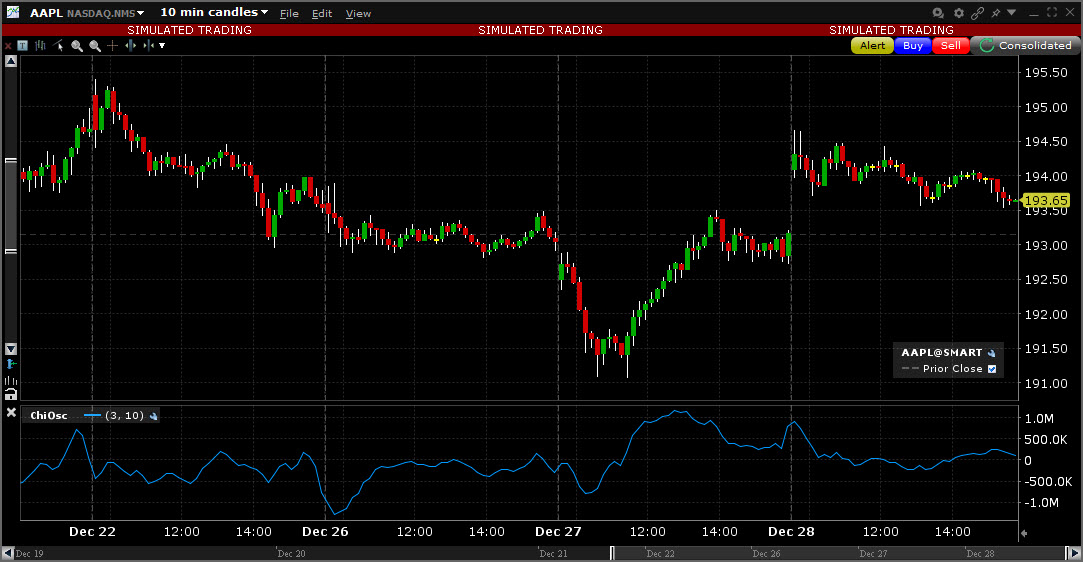
|
| Chande Momentum Oscillator | A technical momentum indicator that is created by calculating the difference between the sum of all recent gains and the sum of all recent losses and then dividing the result by the sum of all price movement over the period. This oscillator is similar to other momentum indicators such as the Relative Strength Index and the Stochastic Oscillator because it is range bounded (+100 and -100). |
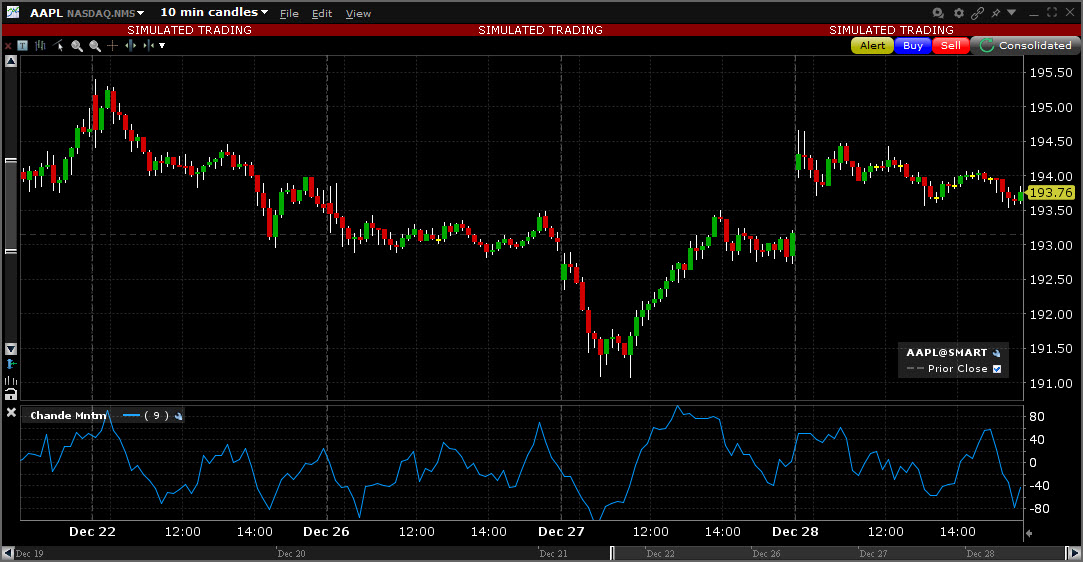
|
| Commodity Channel | The CCI price momentum indicator is designed to identify cyclical turns in commodities pricing, and represents the position of the current price relative to the average of the price over a specified period. |
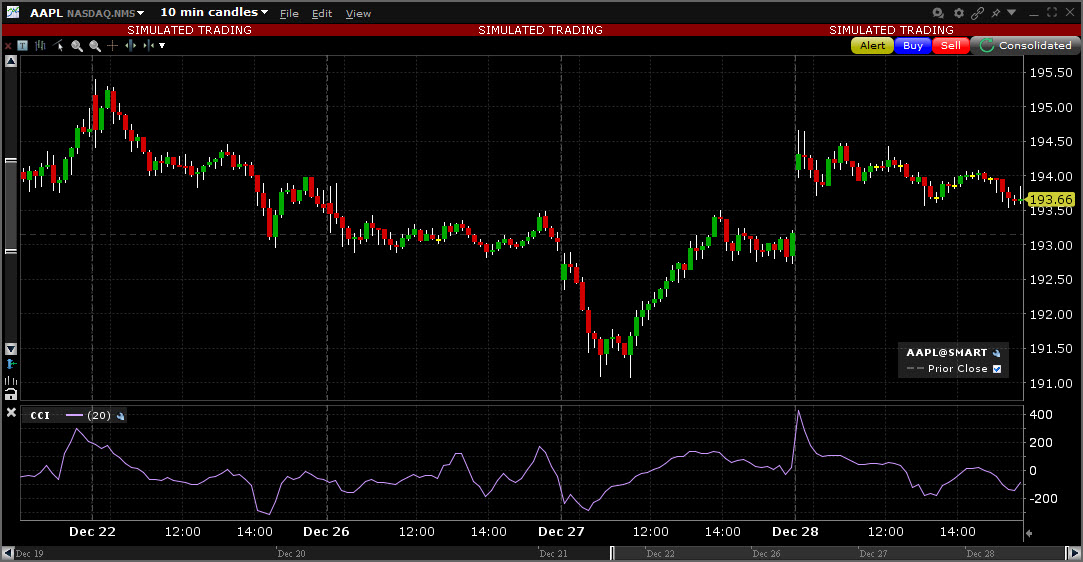
|
| Double Smoothed Stochastics Bressert |
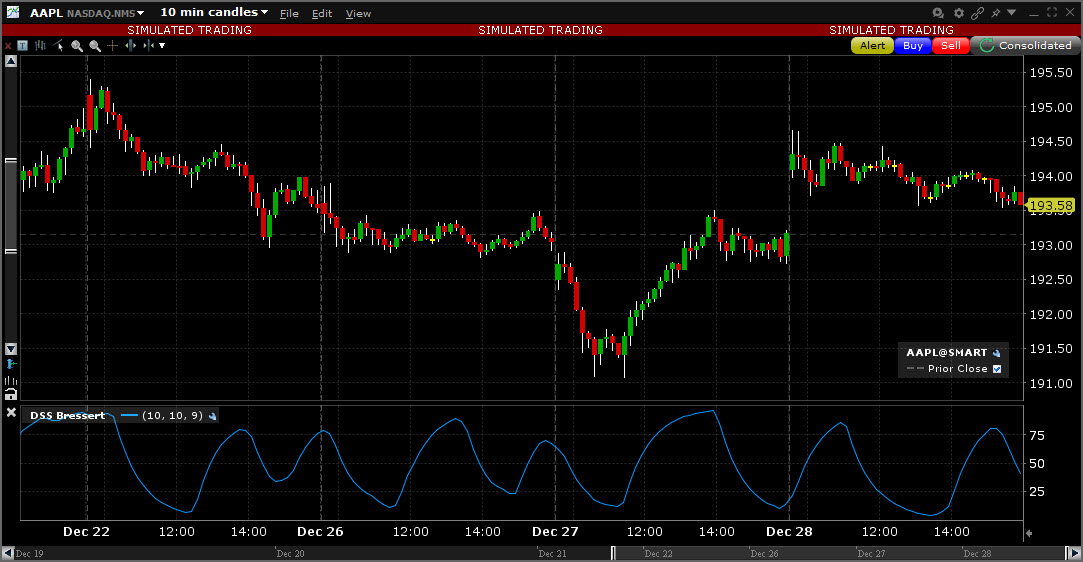
|
|
| Elder-Ray |
Measures the amount of buying and selling pressure in the market. This indicator consists of two separate indicators known as "bull power" and "bear power". These can help a trader to determine the position of the price relative to a certain exponential moving average (EMA). Bull Power = Daily High - n-period EMA Bear Power = Daily Low - n-period EMA Use the values of the bull and bear power along with divergence to help make transaction decisions. Consider taking a long position when the bear power has a value below zero but is increasing, and the bull power's latest peak is higher than it was previously. Consider a short position when the bull-power value is positive but falling, and the bear power's recent low is lower than any other previous bottom. The slope of the EMA can also be used in both cases to help confirm the direction of the trend. |
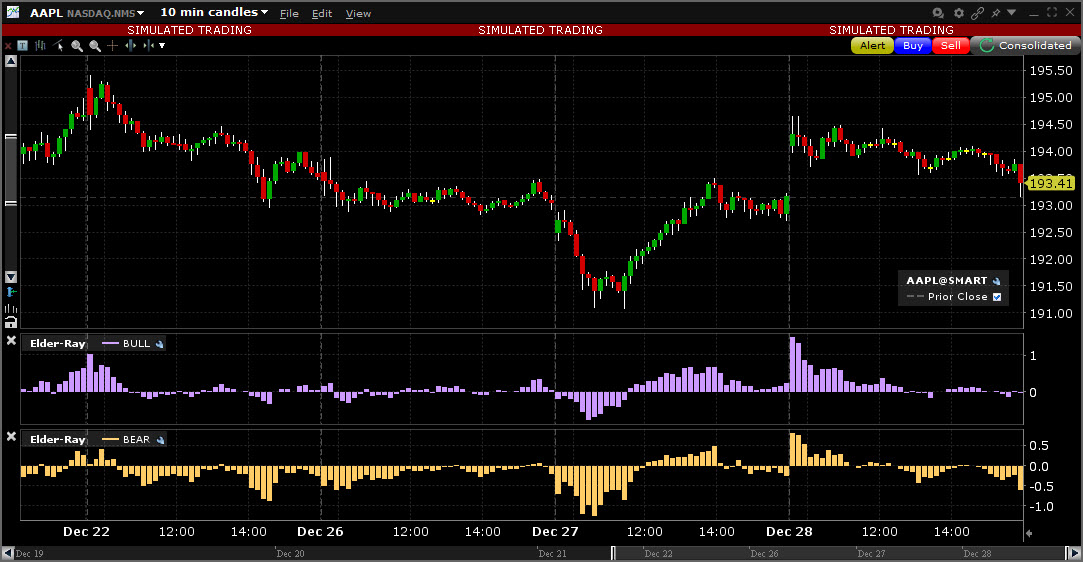
|
| Envelope |
SMA/WMA/EMA Envelopes plot a band composed of two moving averages, one which is shifting upwards, the other shifting downwards, to help define a stock's upper and lower boundaries. The bands of an envelope are calculated as follows: Upper Band = MA(CLOSE, N)*[1+K/100] Lower Band = MA(CLOSE, N)*[1-K/100] Where: MA — Simple (or Weighted or Exponential) Moving Average; N — averaging period; K/100 — the value of shifting from the average (measured in basis points). |

|
| Fast Stochastic Oscillator |
The stochastic oscillator provides information about the location of a current close in relation to the period's high and low. It ranges between 0% and 100%. A reading of 0% indicates that the close was the lowest price at which the security traded during the preceding x number of time periods. A reading of 100% indicates that the close was the highest price at which the security traded during the preceding x number of time periods. This version of the Stochastic Oscillator does not include the Period of slow average. The fast stochastic may be more sensitive to changes in the price of the underlying than the slow version. |
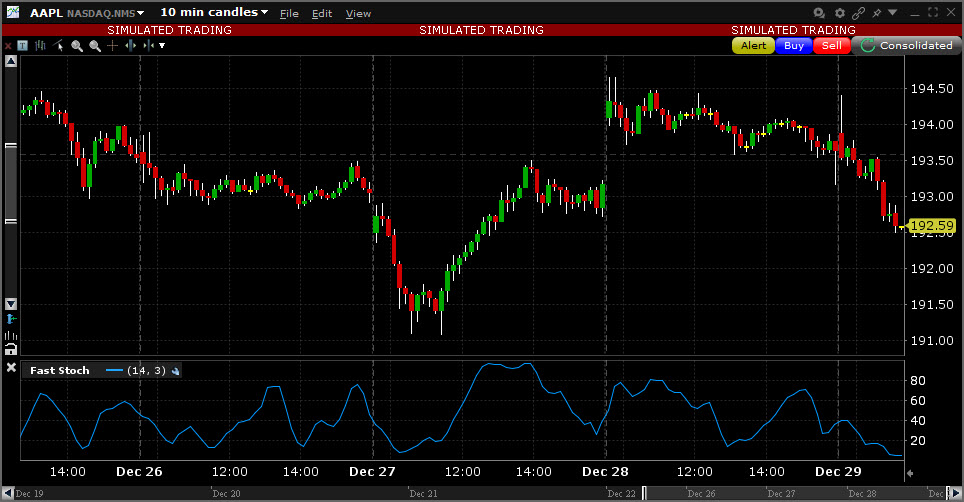
|
| Force Index | The Force Index is an indicator that uses price and volume to assess the power behind a move or identify possible turning points. The Force Index combines all three "essential elements" of a stock's price movement (direction, extent and volume) as an oscillator that fluctuates in positive and negative territory as the balance of power shifts. The Force Index can be used to reinforce the overall trend, identify playable corrections or foreshadow reversals with divergences. |
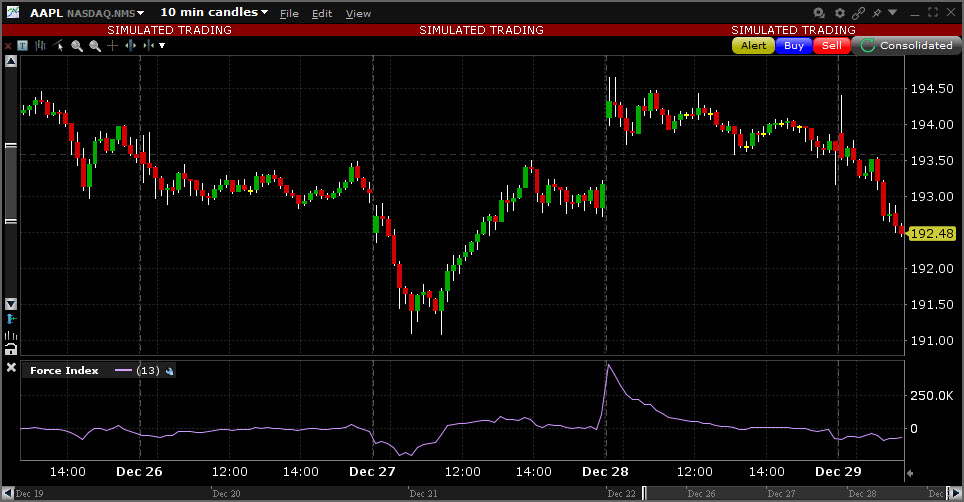
|
| Intraday Intensity | A technical indicator that approximates the volume of trading for a specified security in a given day. It is designed to help track the activity of institutional block traders and is calculated by subtracting the day's high and low from double the closing price, divided by the volume and multiplied by the difference between the high and the low. |

|
| Intraday Intensity % |
Also known at the Money Flow %, calculated as: Intraday Intensity% = Intraday Intensity/Sum(Volume, x) * 100% Where Intraday Intensity = (2 * close - H - L) / (H - L) * volume and x = period of sum, by default = 21 |
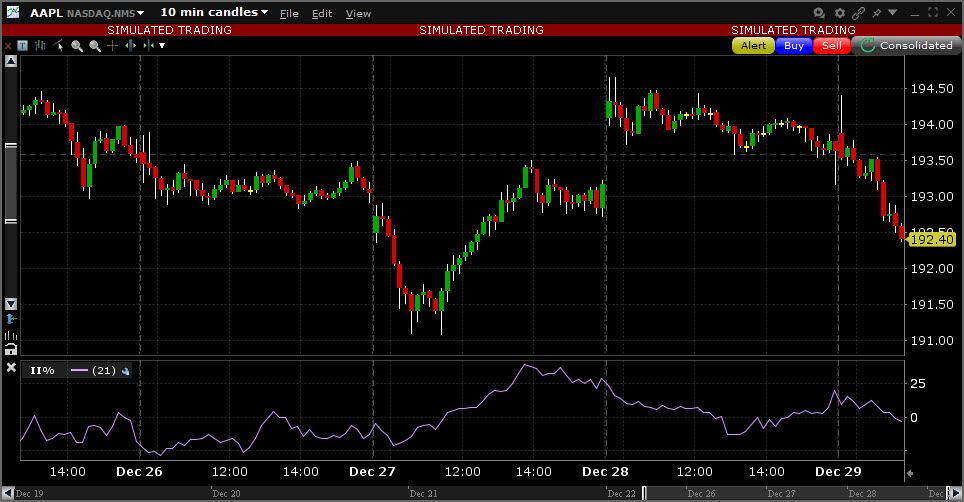
|
| Keltner Channel |
The Keltner Channel indicator is sensitive to volatility, and plots an "envelope" of two bands above and below the middle line, which represents a 20-period Exponential Moving Average (EMA). The upper and lower bands define the area inside of which the price should generally fall. The price crossing or floating towards these lines could indicate a trading opportunity. The Keltner Channel bands are calculated as follows: Middle Line = EMA(TP) Top Line = EMA(TP + Dev x TR) Bottom Line = EMA(TP - Dev x TR) Where: EMA - exponential moving average TP = typical price TR - trade range equals high - low Dev — the deviation factor.
|
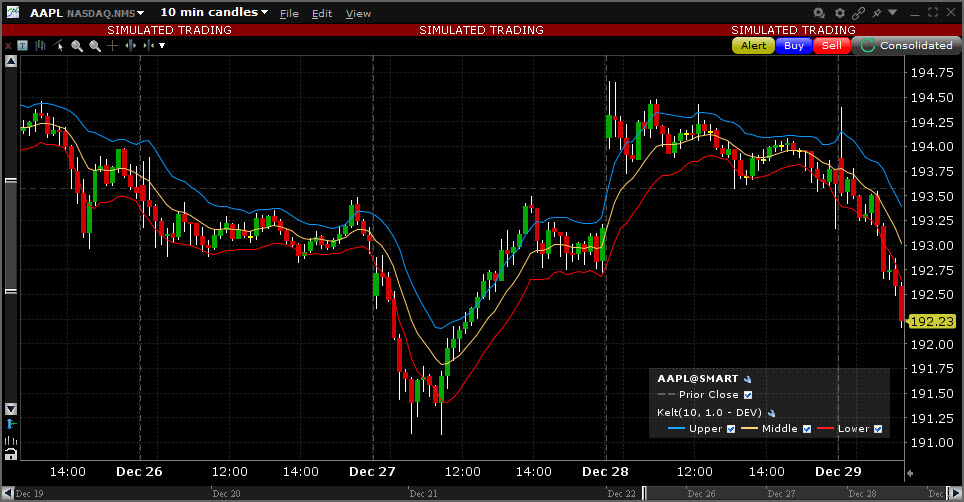
|
| Lane's Stochastic Oscillator |
The stochastic oscillator provides information about the location of a current close in relation to the period's high and low. It ranges between 0% and 100%. A reading of 0% indicates that the close was the lowest price at which the security traded during the preceding x number of time periods. A reading of 100% indicates that the close was the highest price at which the security traded during the preceding x number of time periods. Note: Like the full Stochastic Oscillator, you can edit the source, input price and observation period, but the periods of fast and slow average cannot be edited and the method used is always SMA. use the full Stochastic Oscillator for more flexibility. |
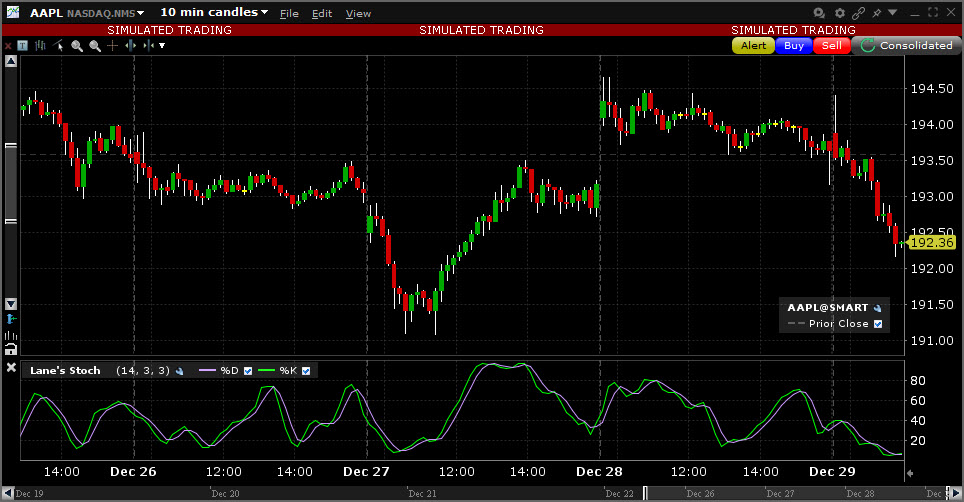
|
| Momentum |
The Momentum is the difference between the current point (price or something else) and the point N periods ago. Momentum is calculated as a ratio of today’s price to the price several (N) periods ago. Momentum = CLOSE(i)/CLOSE(i-N) Where: CLOSE(i) — is the closing price of the current bar. CLOSE(i-N) — is the closing bar price N periods ago |
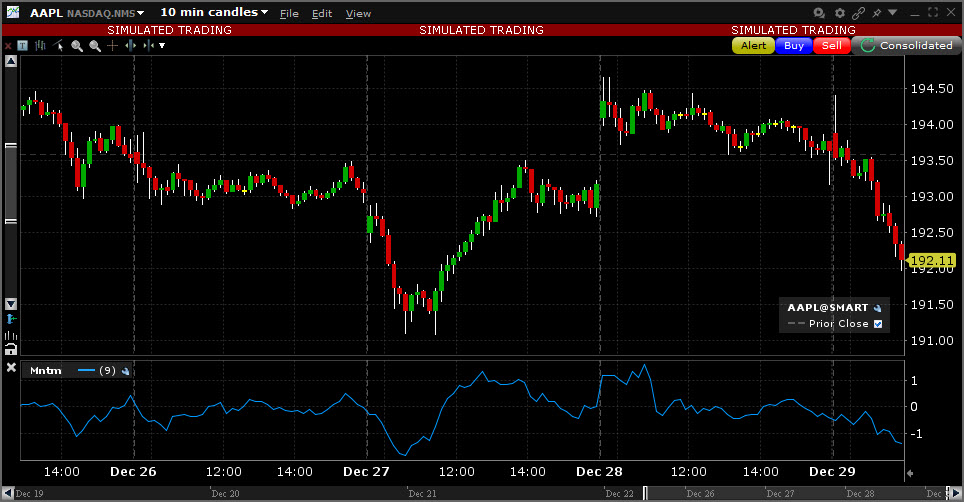
|
| Money Flow Index | The MFI Index is similar to the Relative Strength Index (RSI) indicator, measure on a 0 -100 scale generally over a 14-day period, except that it is volume weighted. This makes it a good measure of the strength of money flowing in and out of a security, and is used to help identify the strength or weakness of a trend. |
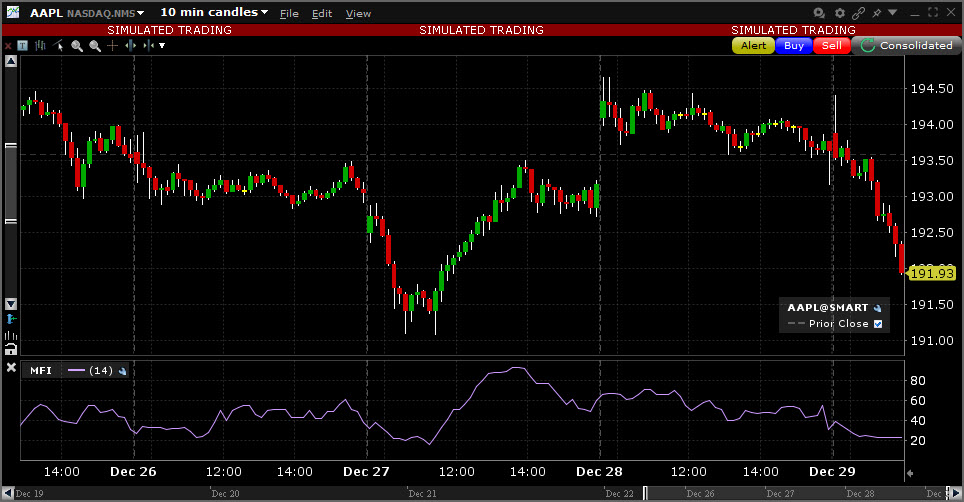
|
| Moving Avg. Conv. Div. |
This is a trend-following dynamic indicator that shows the correlation between two moving averages, generally a 26-period and 12-period SMA or WMA or EMA. You can modify the period length when you create the study. To help illustrate opportunity, a 9-period EMA "signal line" is plotted on top of the MACD. The MACD and signal line are plotted using the following calculations: MACD = MA(CLOSE, 12)-MA(CLOSE, 26) SIGNAL = EMA(MACD, 9) MACD Histogram/OSMA = MACD - SIGNAL Where: MA — Simple or Weighted or Exponential Moving Average; SIGNAL — the signal line of the indicator. |
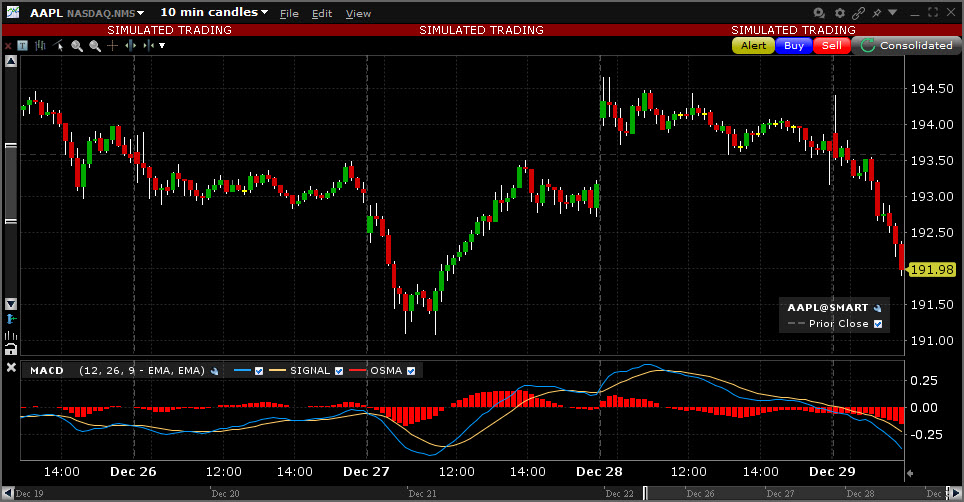
|
| Percentage Price Oscillator | A momentum oscillator for price. Shows the difference between two moving averages as a percentage of the larger moving average. |
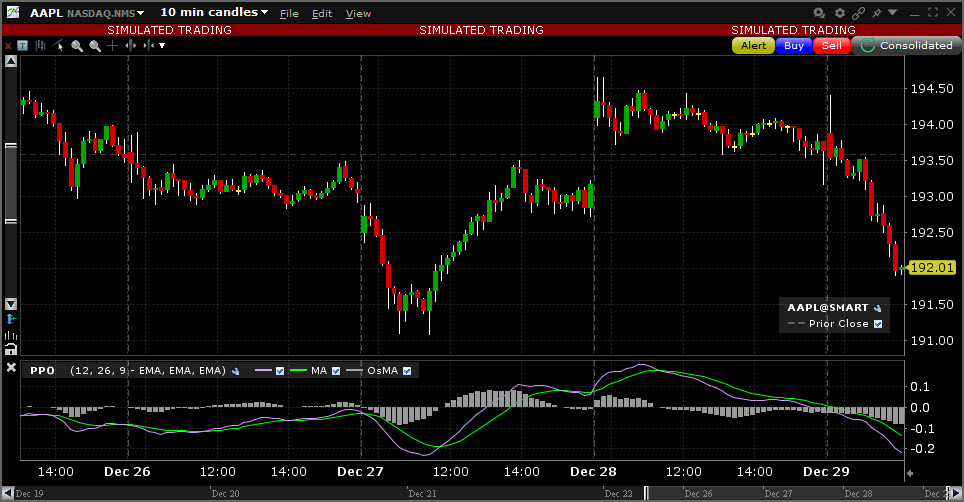
|
| Price Oscillator | Shows the difference between two moving averages, in points. Unlike MACD which always uses the 12- and 26-day moving averages, Price Oscillator can use any two user-specified values. |
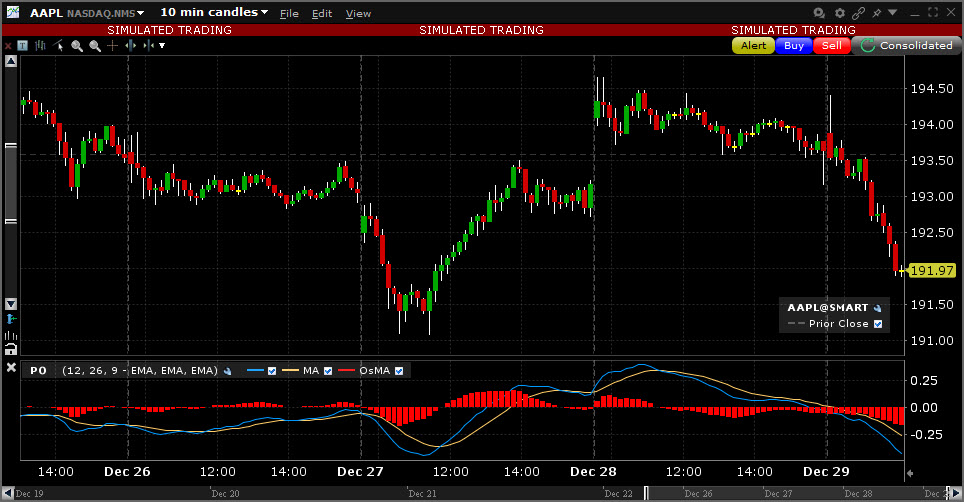
|
| Rate of Change |
ROC is a refined version of Momentum. The readings fluctuate as percentages around the zero line. You set the number of periods when you create the study. Rate of change =100(V/Vx) where: V - the latest closing price. Vx - the closing price of x bars ago. |
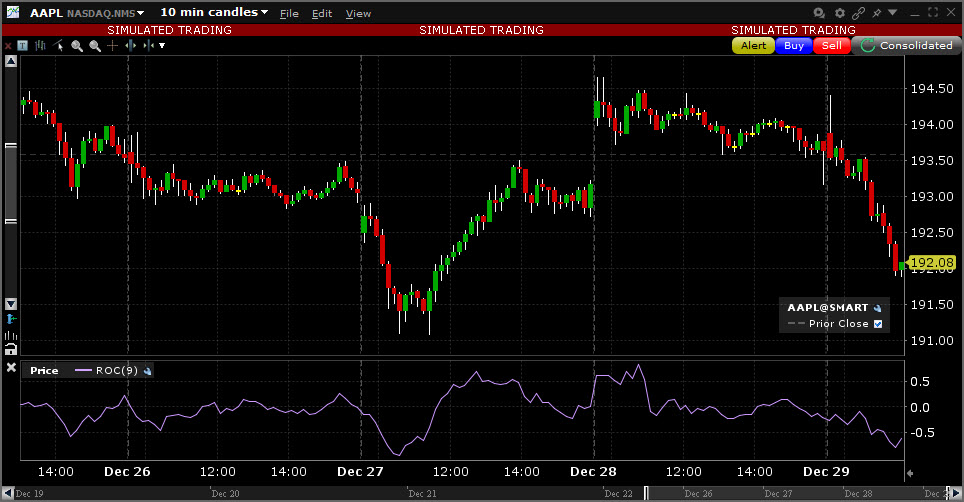
|
| Relative Momentum Index | The Relative Momentum Index (RMI) is a variation of the Relative Strength Index (RSI). While the RMI counts up and down days from today’s close relative to the close ”n-days” ago (n is not limited to 1), the RSI counts days up and down from close to close. |
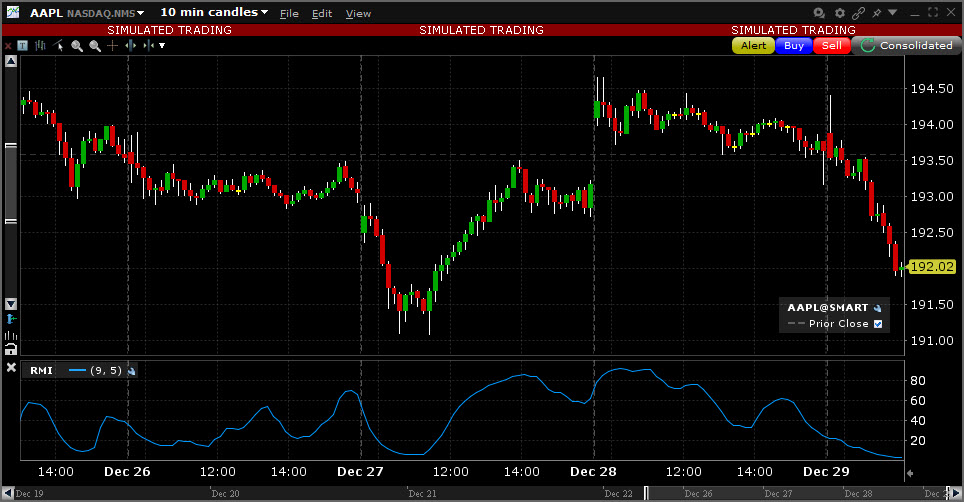
|
| Relative Strength Ind |
The RSI indicator is for overbought/oversold conditions. It goes up when the market is strong, and down when the market is weak, and oscillates between 0 -100. The RSI calculation is: RSI = 100-(100/1+RS) Where: RS - Average of X bars Up Closes/Average X bars Down Closes (X=number of bars set by user) |
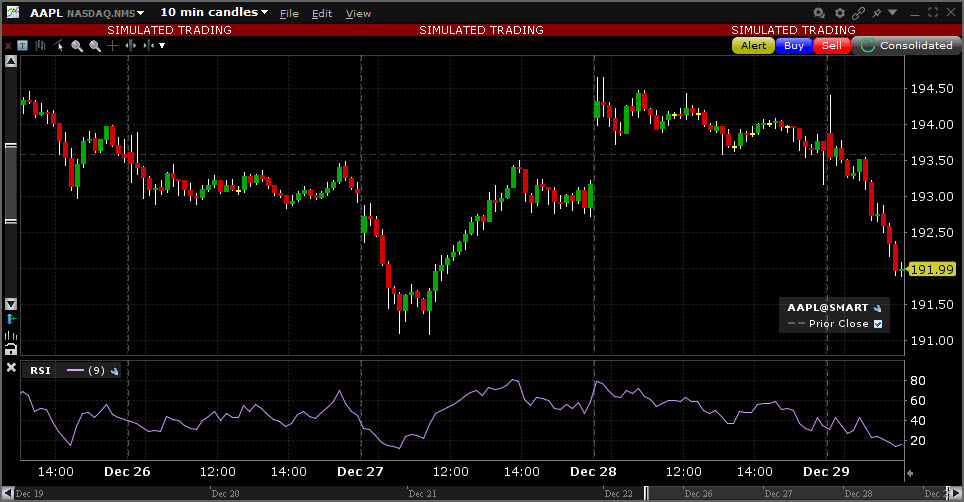
|
| Slow Stochastic Oscillator |
The stochastic oscillator provides information about the location of a current close in relation to the period's high and low. It ranges between 0% and 100%. A reading of 0% indicates that the close was the lowest price at which the security traded during the preceding x number of time periods. A reading of 100% indicates that the close was the highest price at which the security traded during the preceding x number of time periods. This version of the Stochastic Oscillator does not include the Period of fast average and tends to be less sensitive to changes in the price of the underlying than the fast version. |
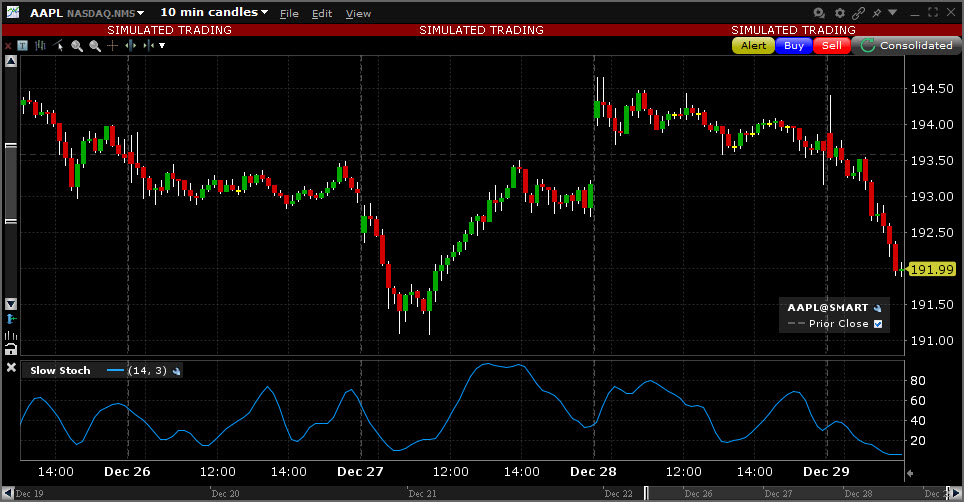
|
| Stochastic Oscillator |
The stochastic oscillator provides information about the location of a current close in relation to the period's high and low. It ranges between 0% and 100%. A reading of 0% indicates that the close was the lowest price at which the security traded during the preceding x number of time periods. A reading of 100% indicates that the close was the highest price at which the security traded during the preceding x number of time periods. Note: You can specify the source and input price, and the observation period, method (SMA, WMA, EMA or TMA), period of slow average and period of fast average when you create the study. |
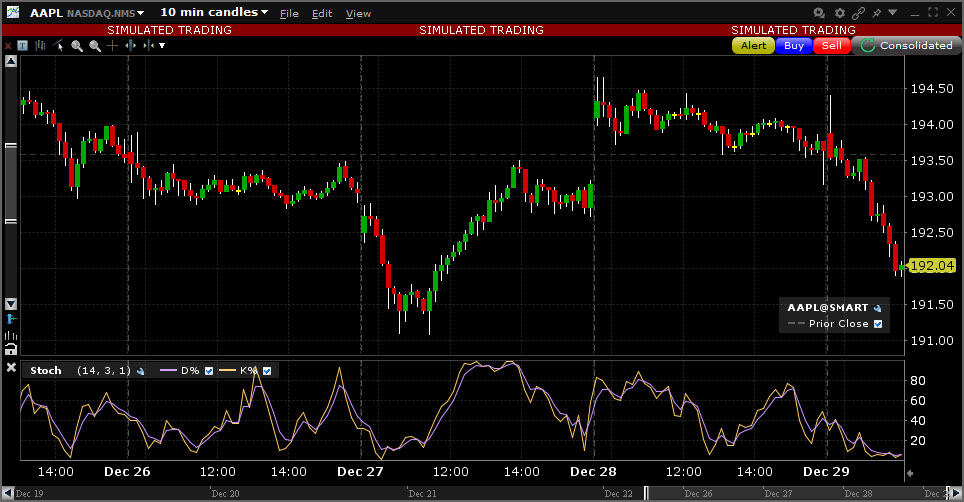
|
| Stochastic RSI | The stochastic oscillator provides information about the location of a current close in relation to the period's high and low. It ranges between 0% and 100%. A reading of 0% indicates that the close was the lowest price at which the security traded during the preceding x number of time periods. A reading of 100% indicates that the close was the highest price at which the security traded during the preceding x number of time periods. The RSI version of this indicator in essence applies the stochastic calculation to the Relative Strength Indicator (RSI). |
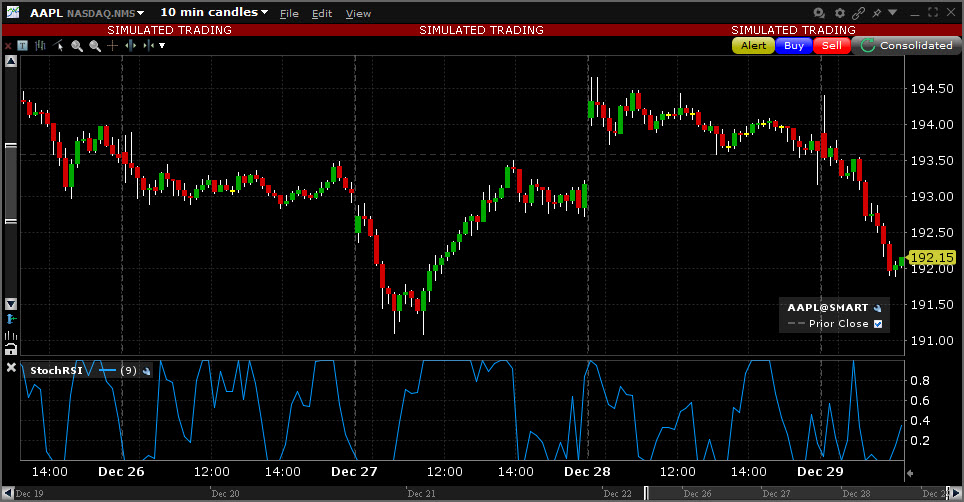
|
| True Strength Index | The True Strength Index is designed to show trend direction and overbought/oversold conditions, and uses moving averages of the underlying momentum of a financial instrument. Momentum is considered a leading indicator of price movement, and a moving average characteristically lags behind price. The TSI combines these two characteristics to create an indication of price and direction more in sync with market turns than either just momentum or just the moving average. |
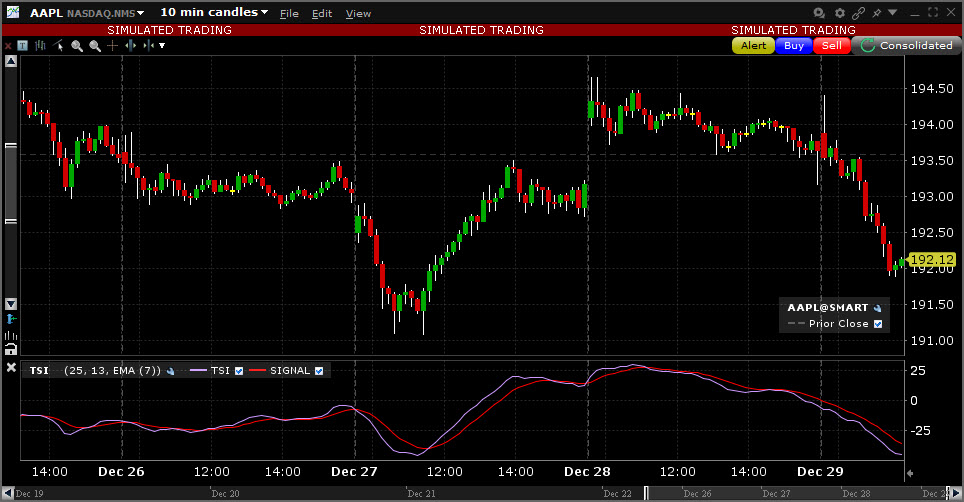
|
| Williams Osc. |
The Williams Percent Range (%R) indicator identifies the overbought/oversold levels. The scale extends from 0 to -100. %R = (HIGH(i-n)-CLOSE)/(HIGH(i-n)-LOW(i-n))-100 Where:
|
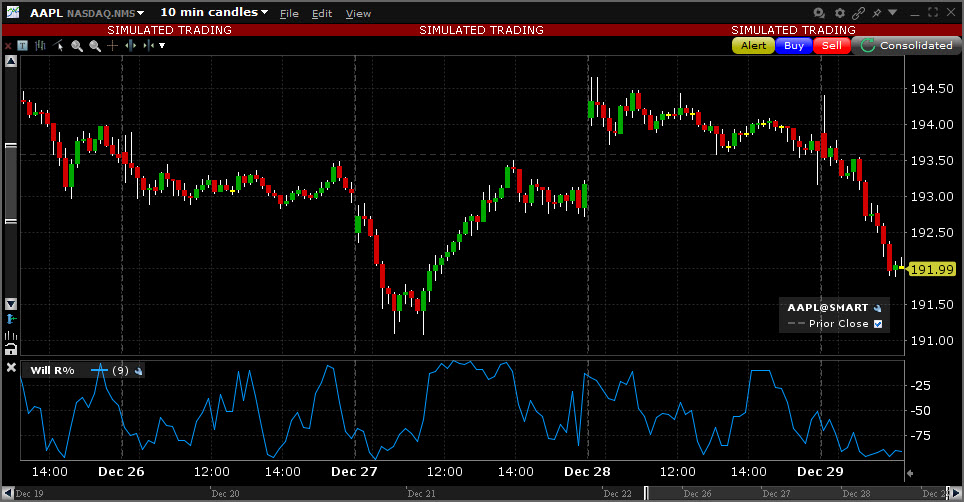
|
| Moving Averages | ||
| Adaptive Moving Average | An Adaptive Moving Average (AMA) is one more moving average overlay, just like EMA. It changes its sensitivity to price fluctuations. The Adaptive Moving Average becomes more sensitive during periods when price is moving in a certain direction and becomes less sensitive to price movement when price is volatile. |
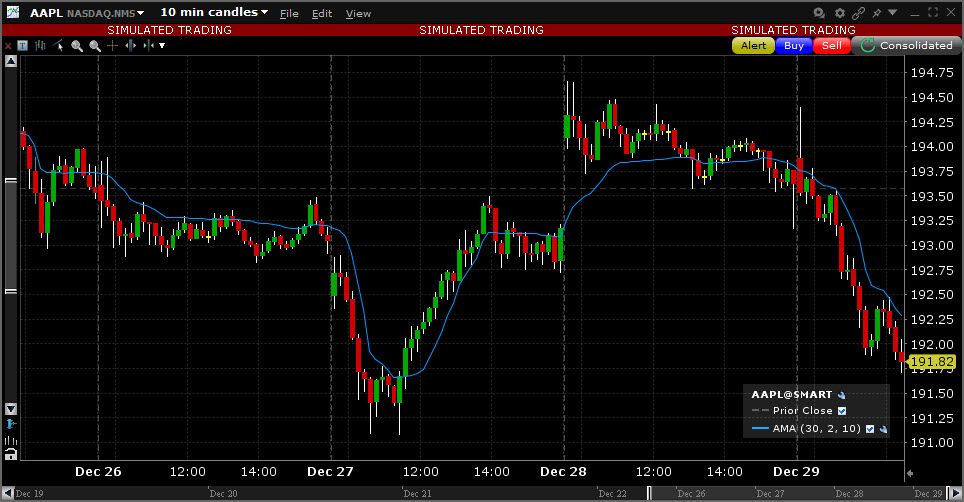
|
| Arnaud Legoux Moving Average | Arnaud Legoux Moving Average (ALMA) removes small price fluctuations and enhances the trend by applying a moving average twice, once from left to right, and once from right to left. At the end of this process the phase shift (price lag) commonly associated with moving averages is significantly reduced. Zero-phase digital filtering reduces noise in the signal. Conventional filtering reduces noise in the signal, but adds a delay. |
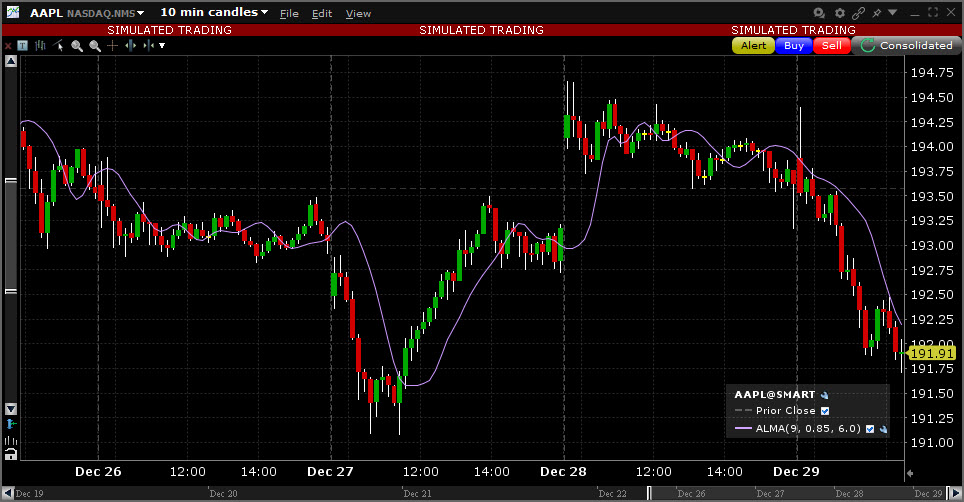
|
| Bollinger Band Width | Bollinger Band Width is derived from Bollinger Bands and measures the percent difference between the upper and lower bands. It decreases as Bollinger Bands narrow and increases as Bollinger Bands widen. Because Bollinger Bands are based on the standard deviation, falling Band Width reflects decreasing volatility and rising Band Width reflects increasing volatility. |
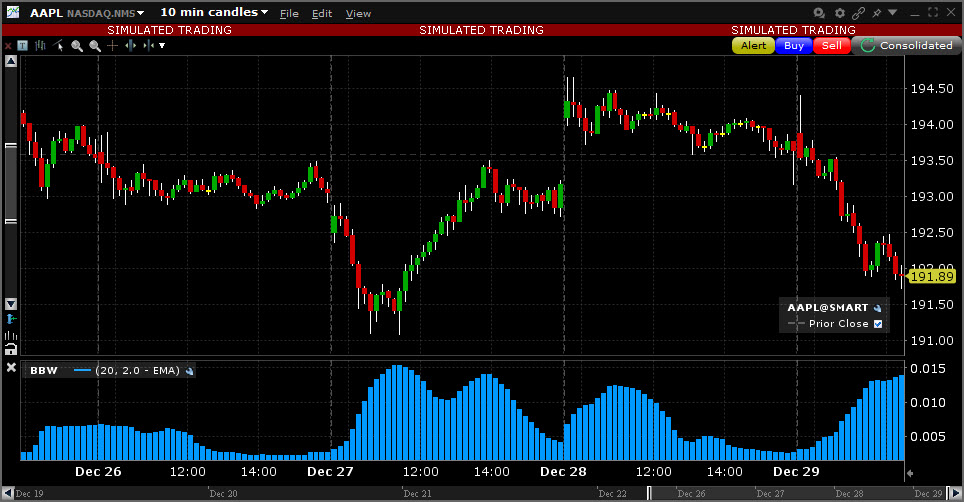
|
| Bollinger Bands | Bollinger Bands measure volatility by plotting a series of three bands. The middle band represents the moving average (SMA or WMA or EMA). The upper band is a set number of standard deviations higher than the middle band (generally 2), and the lower band is a set number of standard deviations (generally 2) lower than the middle band. You set the distance of standard deviation when you create the study. |
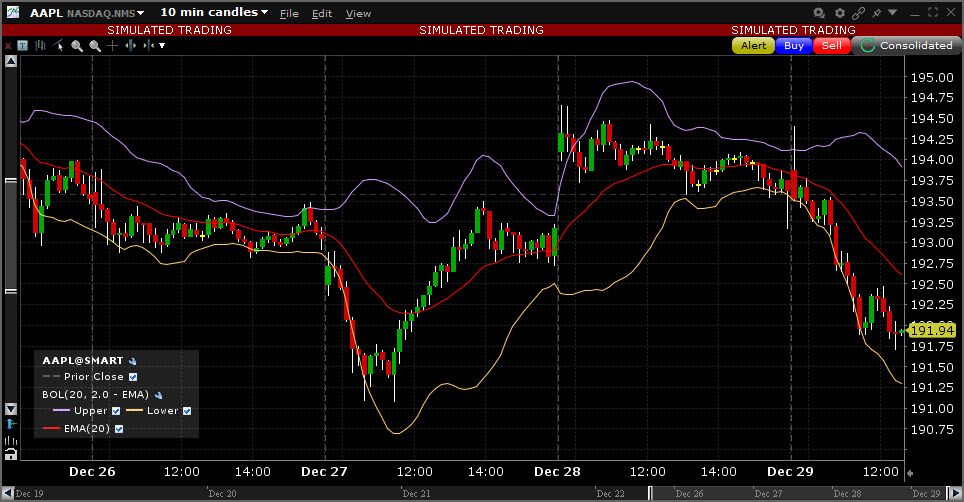
|
| Departure Chart | One of the oldest technical studies, the Departure Chart measures the difference between two moving averages of price; one short and one long. Its primary use is as a trend identification tool, but it may also be used to identify overbought and oversold conditions as well. Default periods are 10 and 20. |

|
| Double Exponential Moving Avg. | Based on both a single exponential moving average (EMA) and a double EMA, the DEMA is a fast-acting moving average that is more responsive to market changes than a traditional moving average. It was developed in an attempt to create a calculation that eliminated some of the lag associated with traditional moving averages. |
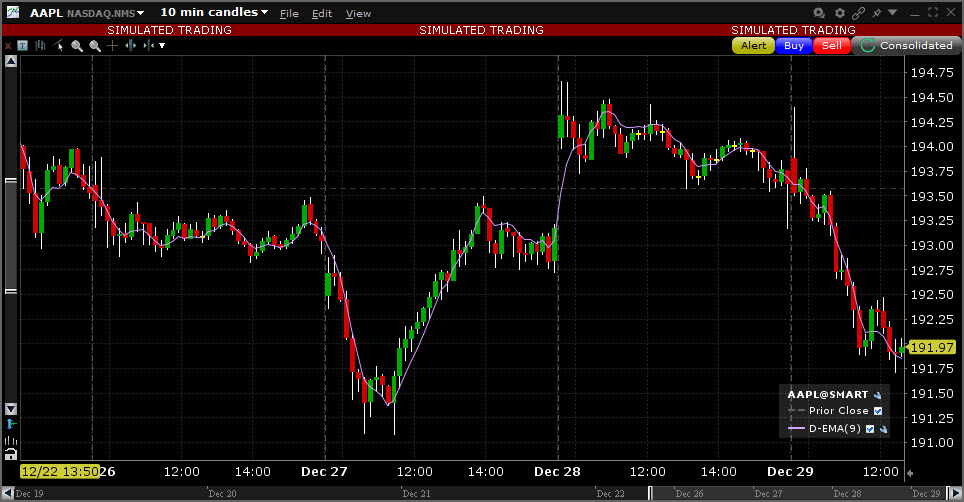
|
| Ease of Movement | A technical momentum indicator that can help illustrate the relationship between the rate of an asset's price change and its volume. This indicator attempts to identify the amount of volume required to move prices. Generally a value greater than zero is an indication that the stock is being accumulated (bought) and negative values are used to signal increased selling pressure. A high positive value appears when prices move upward on low volume. Strong negative numbers indicate that price is moving downward on low volume. |
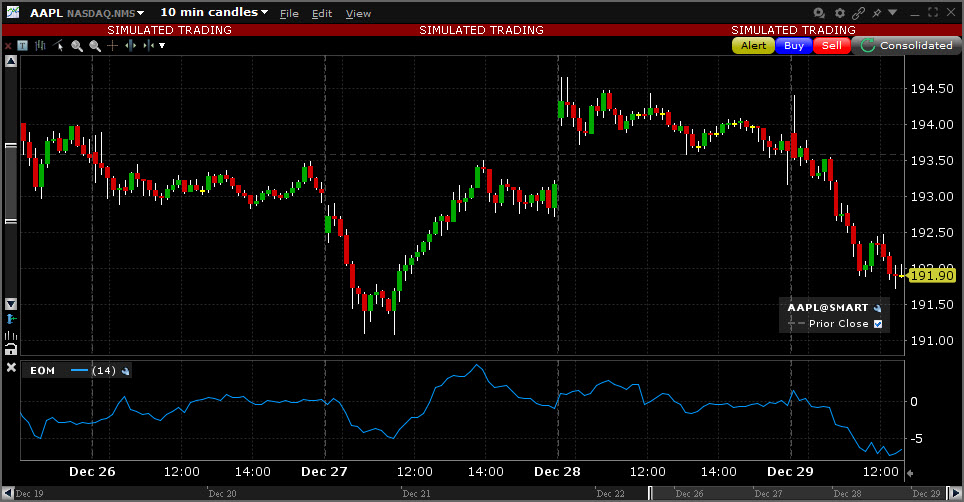
|
| Exponential Moving Avg. |
The exponential moving average gives more weight to the latest prices and includes all of the price data in the life of the instrument. It is defined by taking: (previous period's exponential moving average)/(N+1) and adding (current price)*2/(N+1). For the first period we take the simple average as above. |
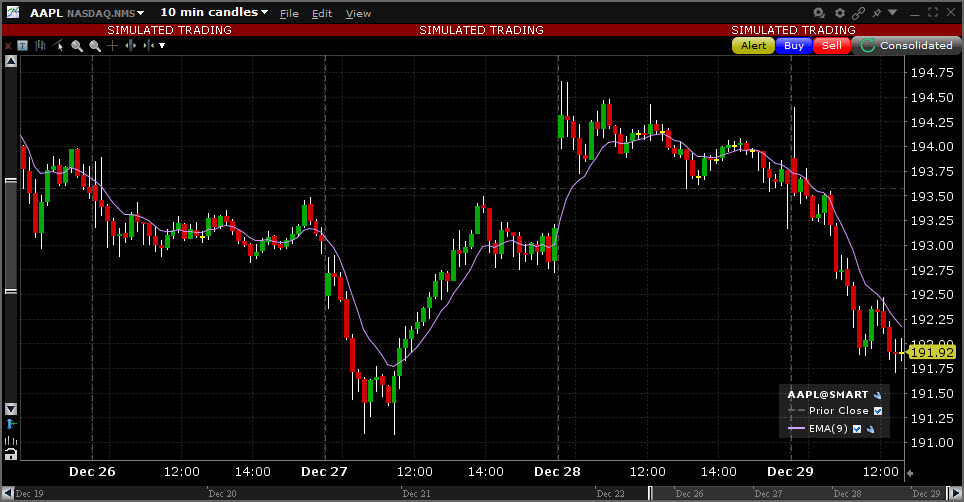
|
| Hull Moving Average | The Hull moving average indicator improves on smoothing price fluctuations, and also accounts for price lag. It does this by using the square root of a given period instead of the actual period itself. |
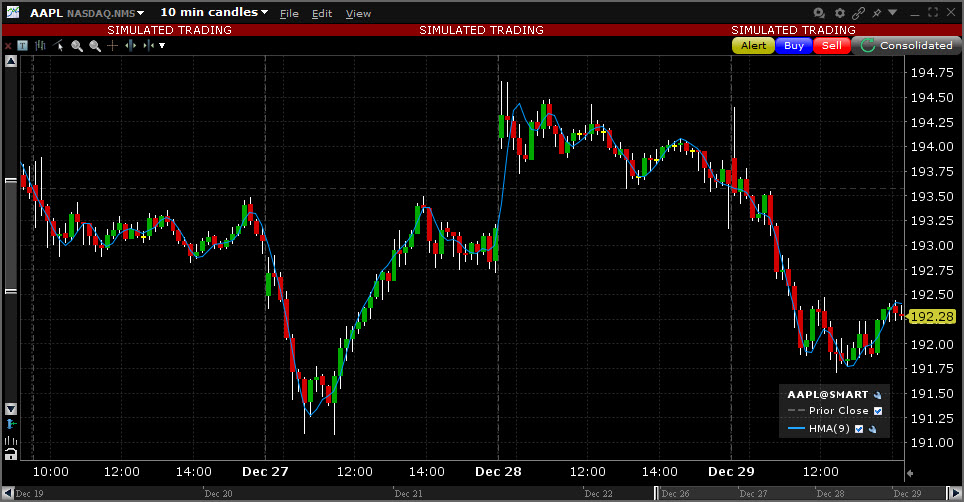
|
| Know Sure Thing |
A two-line indicator used to determine momentum in stock trends. As an oscillator, it fluctuates above and below zero, providing trade signals and analytical insight based on divergence with price and KST and signal Line crossovers. The indicator formula uses four different time frames to show overall momentum (rather than momentum over only one specific timeframe):
While the formulas are different, the applications of KST are similar to those of the MACD. |
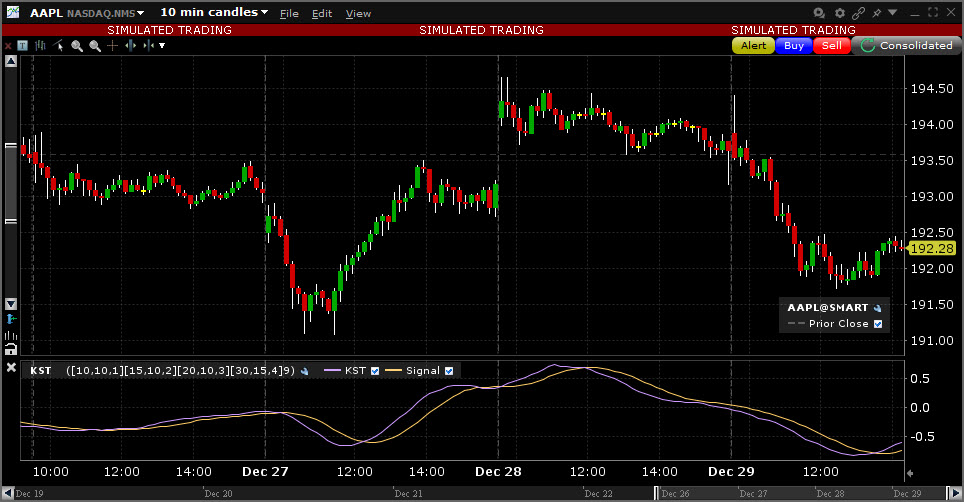
|
| MA Crossover | A crossover occurs when a faster Moving Average (a shorter period moving average) crosses either above or below a slower (i.e. longer period) moving average. A crossover that moves above a slower MA is considered a bullish crossover; one that moves below is considered a bearish crossover. |
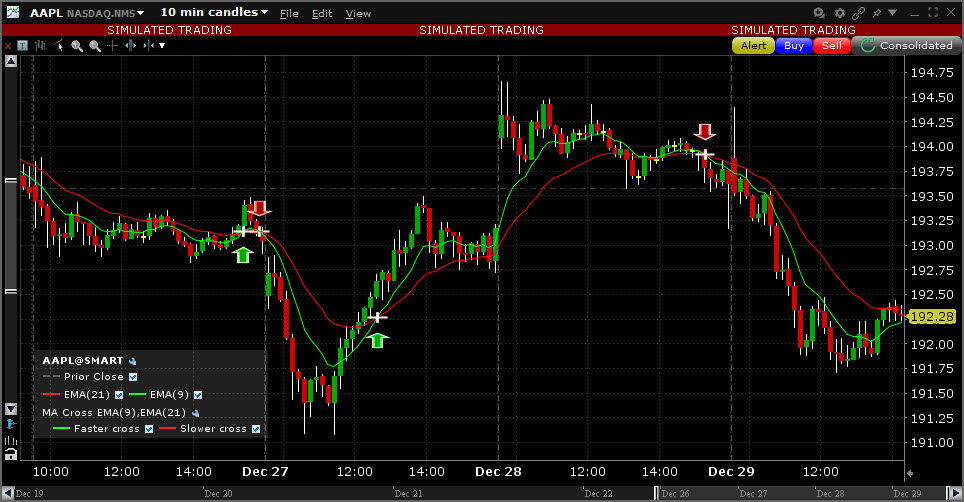
|
| McGinley Dynamic | The McGinley Dynamic is a smoothing mechanism for prices that often tracks far better than any moving average. It minimizes price separation and price whipsaws and hugs prices much more closely. Because of the calculation, the Dynamic Line speeds up in down markets as it follows prices yet moves more slowly in up markets. |
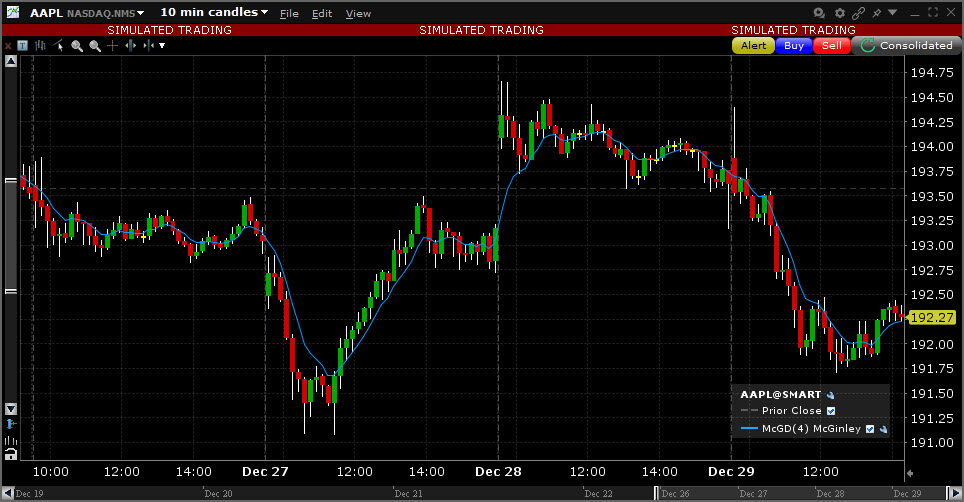
|
| Moving Standard Deviation | Standard deviation is a statistical term that provides a good indication of volatility. It measures how widely values (for example, closing prices) are dispersed from the average. Dispersion is the difference between the actual value (closing price) and the average value (mean closing price). The larger the difference between the closing prices and the average price, the higher the standard deviation will be and the higher the volatility. The nearer the closing prices are to the average price, the lower the standard deviation and the lower the volatility. |
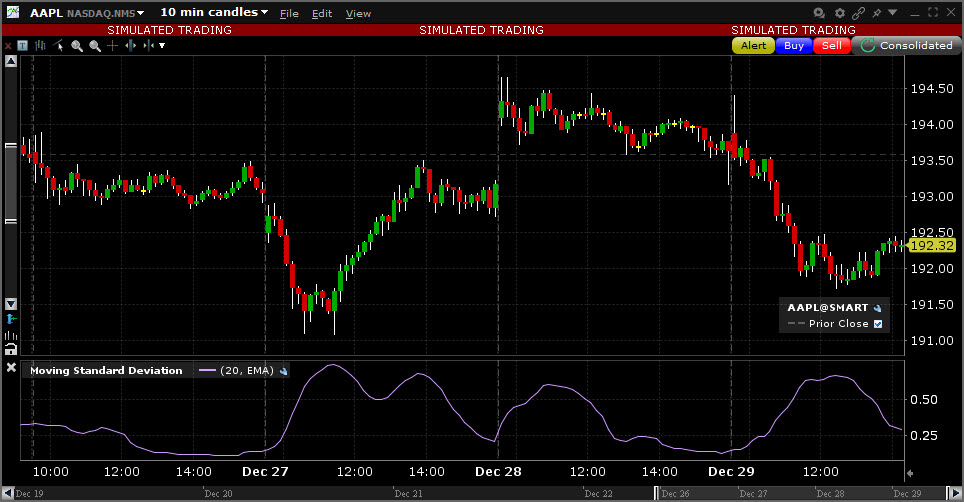
|
| Percent B |
%B quantifies a security's price relative to the upper and lower Bollinger Band. There are six basic relationship levels:
The default setting for %B is based on the default setting for Bollinger Bands (20,2). The bands are set two standard deviations above and below the 20-day simple moving average, which is also the middle band. The security price used is the closing price or the last trade. |
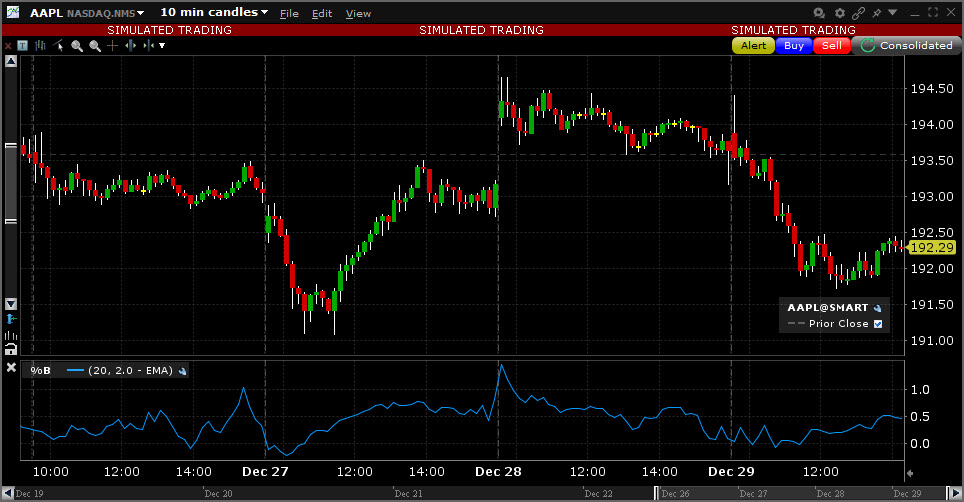
|
| Simple Moving Avg. |
The simple moving average sums the prices (you can choose from the closing price, the VWAP time-weighted price or the high/low/close average price) for a specific number of data points and divides by that number. The calculation for a 3-bar simple moving average is: (price_1) + (price_2) + (price_3) divided by 3 |

|
| TRIX | TRIX is a momentum oscillator that displays the percent rate of change of a triple exponentially smoothed moving average. TRIX is designed to filter out insignificant price movements with its triple smoothing. TRIX generates signals similar to MACD, and a signal line can be applied to look for signal line crossovers. A directional bias can be determined with the absolute level. Bullish and bearish divergences can be used to anticipate reversals. |
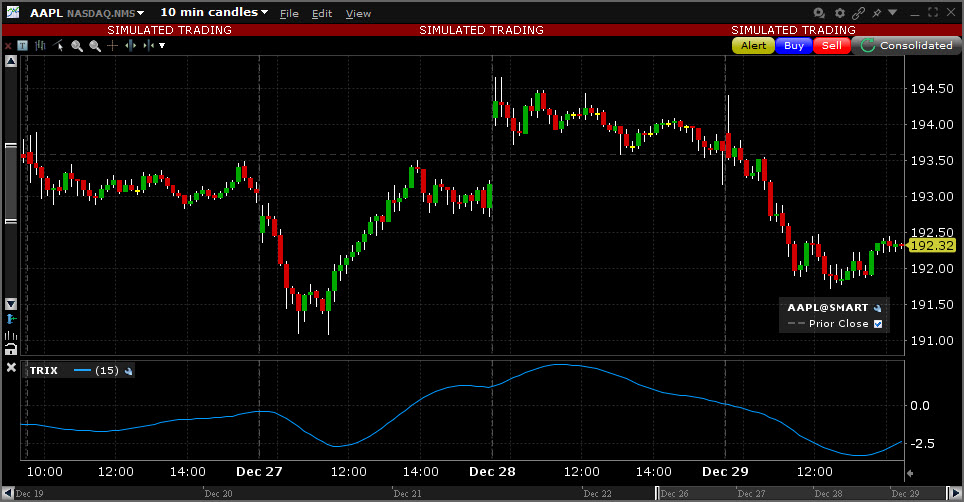
|
| Triangular Moving Average |
The Triangular Moving Average is basically a double-smoothed Simple Moving Average that gives more weight to the middle section of the data interval. The TMA has a significant lag to current prices and is not well-suited to fast moving markets. TMA = SUM (SMA values)/ N Where N = the number of periods. |
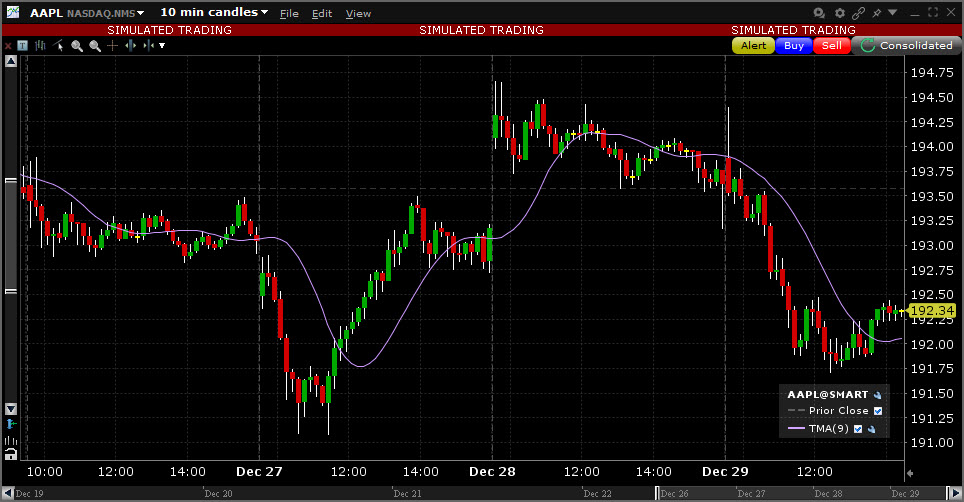
|
| Triple Exponential Moving Avg. |
A technical indicator used for smoothing price and other data. It is a composite of a single exponential moving average, a double exponential moving average and a triple exponential moving average. The TEMA smooths price fluctuations and filters out volatility, thereby making it easier to identify trends with little lag. It is a useful tool in identifying strong, long lasting trends, but may be of limited use in range-bound markets with short term fluctuations. |
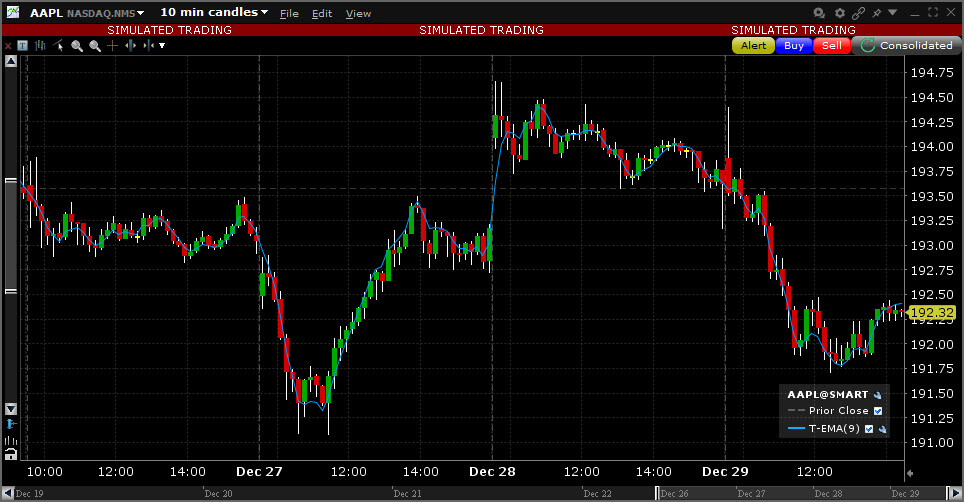
|
| Ultimate Osc. |
The Ultimate Oscillator combines the price action for three different time frames. You set the observations periods 1, 2, and 3 when you create the study. Time Frames:
Buying pressure sum 1, buying pressure sum 2 and buying pressure sum 3 are calculated by adding up buying pressures for 3 different time frames. The same applies to the true range sum 1, 2 and 3. raw ultimate oscillator = 4 * (buying pressure sum 1 / true range sum 1) + 2 * (buying_pressure_sum_2 / true_range_sum_2) + (buying_pressure_sum_3 / true_range_sum_3) ultimate oscillator = raw ultimate oscillator / (4 + 2 + 1) ) * 100 |

|
| Variable Moving Average | This is an exponential moving average that adjusts its smoothing constant on the basis of market volatility. Its sensitivity grows as long as the volatility of the data increases. The performance of this exponential moving average is improved by using a Volatility Index (VI) to adjust the smoothing period as market conditions change. |

|
| Weighted Moving Avg. |
The weighted moving average gives each data point a weight proportionate to its number in the sequence and divides by the sum of its weights. The calculation for a 3-bar weighted moving average is: (1 x price_1) + (2 x price_2) + (3 x price_3) divided by 6, where 6 is the sum of the weights (1 + 2 + 3). |
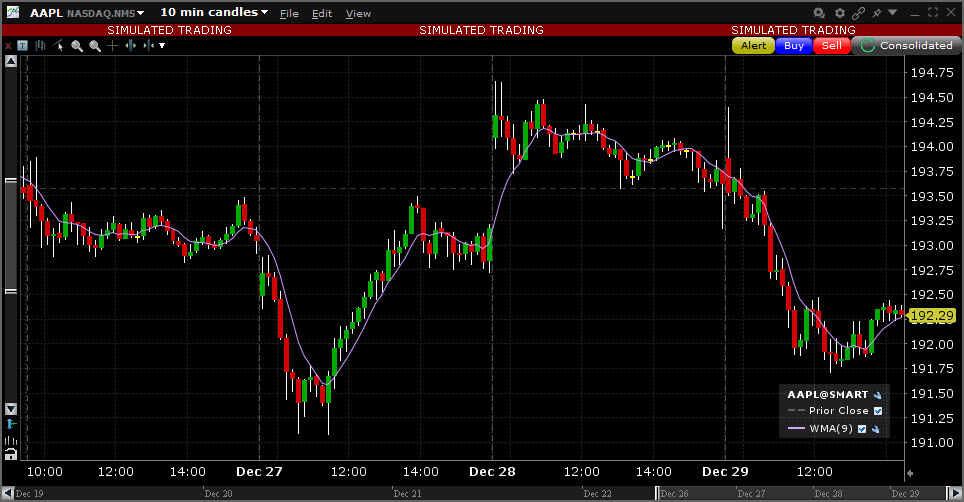
|
| Wilder Moving Average | Also called Wilder's Smoothed Moving Average, this indicator is similar to the Exponential Moving Average. Compared to other moving averages, Wilders MA responds more slowly to price changes, where an n-period Wilder MA gives similar values to a 2n- period EMA. For example, a 14-period EMA has almost the same values as a 7-period Wilder MA. |
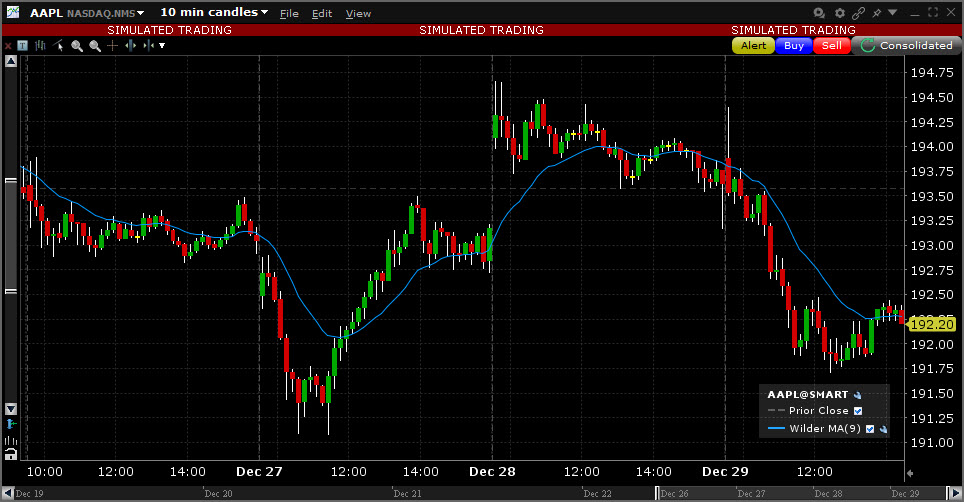
|
| Pivot Studies | ||
| Camarilla Pivot Points |
Pivot point studies highlight prices considered to be a likely turning point when looking at values from a previous period, whether it be daily, weekly, quarterly or annual. Each pivot point study has its own characteristics on how these points are calculated. The formula applied for the Camarilla Pivot Points is: Define: Range = High - Low Pivot Point (P) = (High + Low + Close) / 3 Support 1 (S1) = Close - Range * (1.1 / 12) Support 2 (S2) = Close - Range * (1.1 / 6) Support 3 (S3) = Close - Range * (1.1 / 4) Support 4 (S4) = Close - Range * (1.1 / 2) Support 5 (S5) = Close - (R5 - Close) Resistance 1 (R1) = Close + Range * (1.1 / 12) Resistance 2 (R2) = Close + Range * (1.1 / 6) Resistance 3 (R3) = Close + Range * (1.1 / 4) Resistance 4 (R4) = Close + Range * (1.1 / 2) Resistance 5 (R5) = (High/Low) * Close |
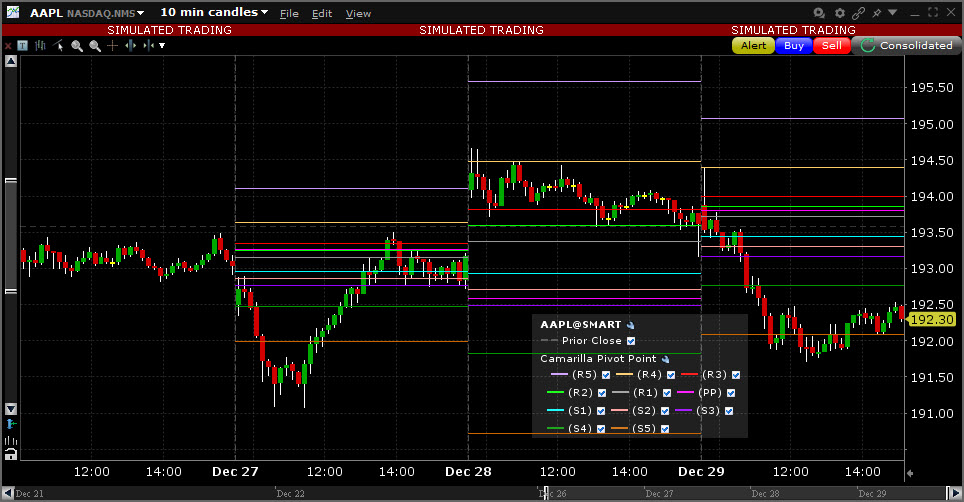
|
| DeMark Pivot Points |
Pivot point studies highlight prices considered to be a likely turning point when looking at values from a previous period, whether it be daily, weekly, quarterly or annual. Each pivot point study has its own characteristics on how these points are calculated. The formula applied for the DeMark Pivot Points is: If Close < Open, then X = High + (2 * Low) + Close If Close > Open, then X = (2 * High) + Low + Close If Close = Open, then X = High + Low + (2 * Close) Pivot Point (P) = X/4 Support 1 (S1) = X/2 - High Resistance 1 (R1) = X/2 - Low |
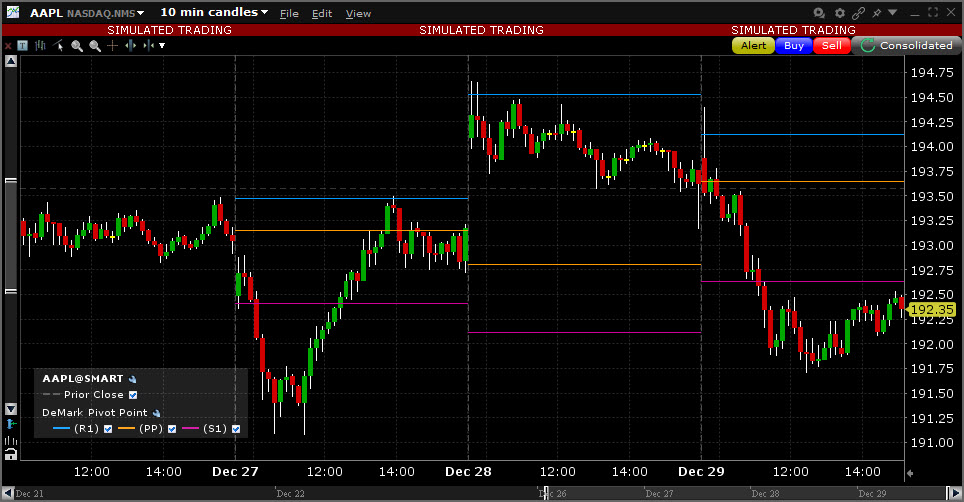
|
| Fibonacci Pivot Points |
Pivot point studies highlight prices considered to be a likely turning point when looking at values from a previous period, whether it be daily, weekly, quarterly or annual. Each pivot point study has its own characteristics on how these points are calculated. The formula applied for the Fibonacci Pivot Points is: Pivot Point (P) = (High + Low + Close)/3 Support 1 (S1) = P - {.382 * (High - Low)} Support 2 (S2) = P - {.618 * (High - Low)} Support 3 (S3) = P - {1 * (High - Low)} Resistance 1 (R1) = P + {.382 * (High - Low)} Resistance 2 (R2) = P + {.618 * (High - Low)} Resistance 3 (R3) = P + {1 * (High - Low)} |
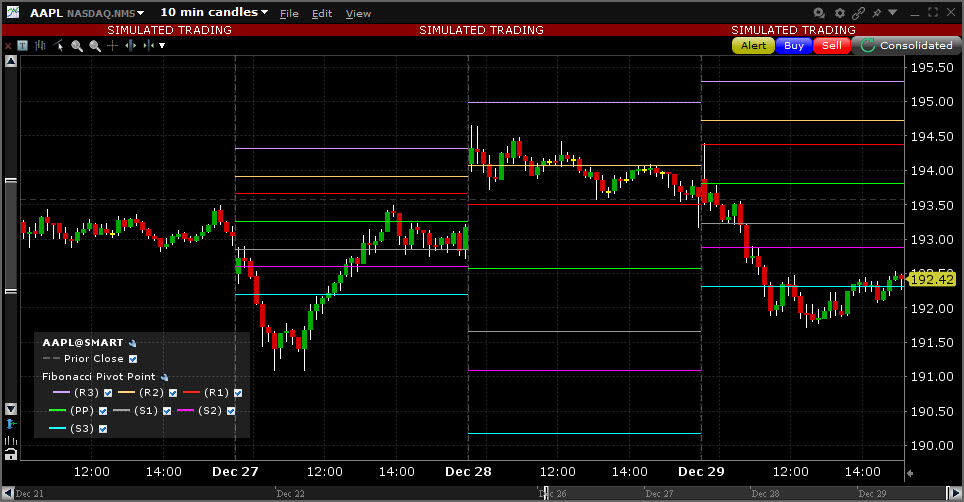
|
| Floor Pivot Points |
Pivot point studies highlight prices considered to be a likely turning point when looking at values from a previous period, whether it be daily, weekly, quarterly or annual. Each pivot point study has its own characteristics on how these points are calculated. The formula applied for the Floor Pivot Points is: Pivot Point (P) = (High + Low + Close)/3 Support 1 (S1) = 2 * P - High Support 2 (S2) = P - (High - Low) Support 3 (S3) = S1 - (High - Low) Resistance 1 (R1) = 2 * P - Low Resistance 2 (R2) = P + (High - Low) Resistance 3 (R3) = R1 + (High - Low) |
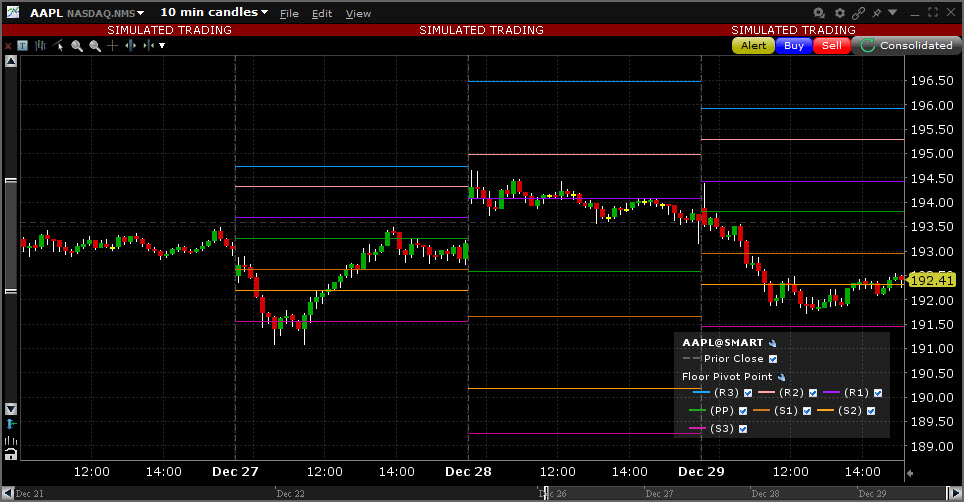
|
| Pivot Points |
The Pivot Point indicator calculates the numerical average of a stock's high, low and closing prices, and is used to help identify resistance and support levels. We calculate pivot points using the five-point system, which uses the previous day's high, low and close to get the pivot point, and then calculates two resistance levels and two support levels, as follows: R2=P + (H-L) = P + (R1-S1) R1 = (P x 2) - L P = (H + L + C) /3 S1 = (P x 2) - H S2 = P - (H - L) = P - (R1 - S1) where "S" is the support levels, "R" is the resistance levels, "P" is the pivot point, H, L, C are high, low and close, respectively. |
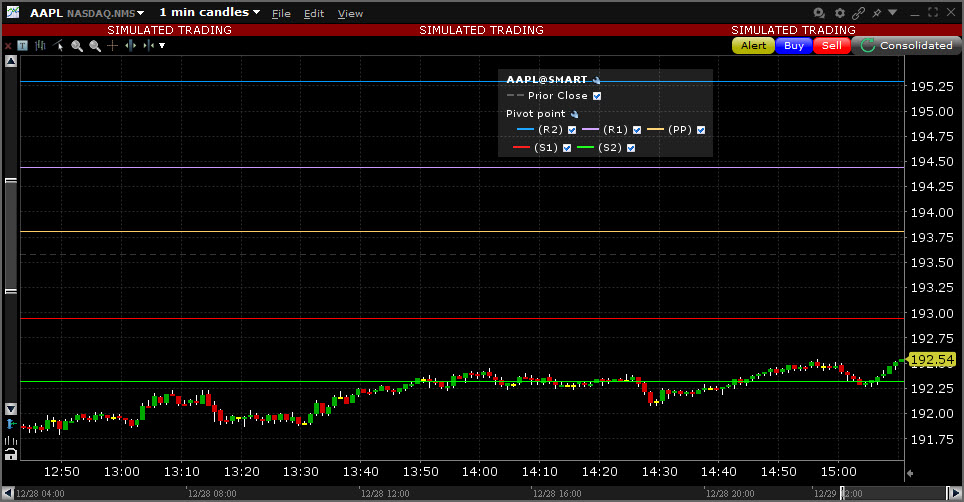
|
| Pivot Points High/Low | Pivot points are used to project potential support and resistance levels. Main time periods are daily, weekly and monthly. |
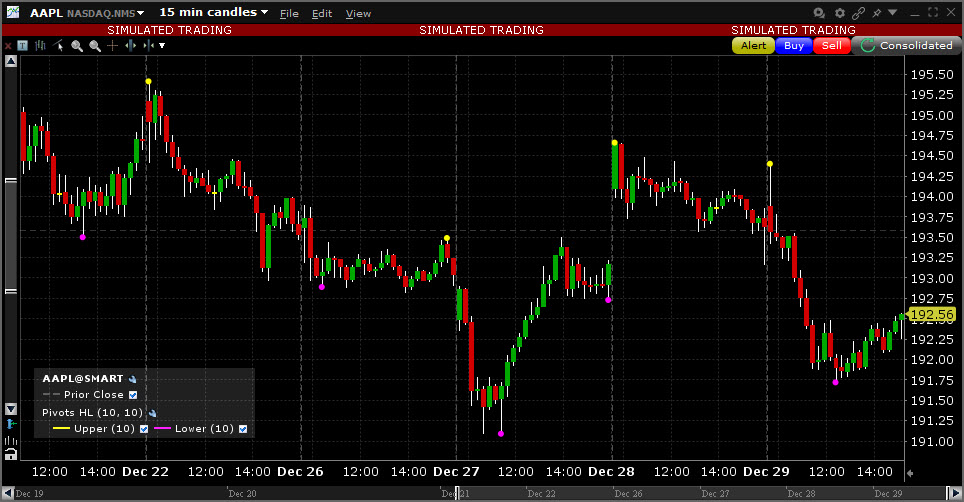
|
| Woodie Pivot Points |
Pivot point studies highlight prices considered to be a likely turning point when looking at values from a previous period, whether it be daily, weekly, quarterly or annual. Each pivot point study has its own characteristics on how these points are calculated. The formula applied for the Woodie Pivot Points is: Define: Range = High - Low Pivot Point (P) = (High + Low + (Period's Open * 2)) / 4 Support 1 (S1) = (2 * P) - High Support 2 (S2) = P - Range Support 3 (S3) = Low - 2 * (High - P) Support 4 (S4) = S3 - Range Resistance 1 (R1) = (2 * P) - Low Resistance 2 (R2) = P + Range Resistance 3 (R3) = High + 2 * (P - Low) Resistance 4 (R4) = R3 + Range |
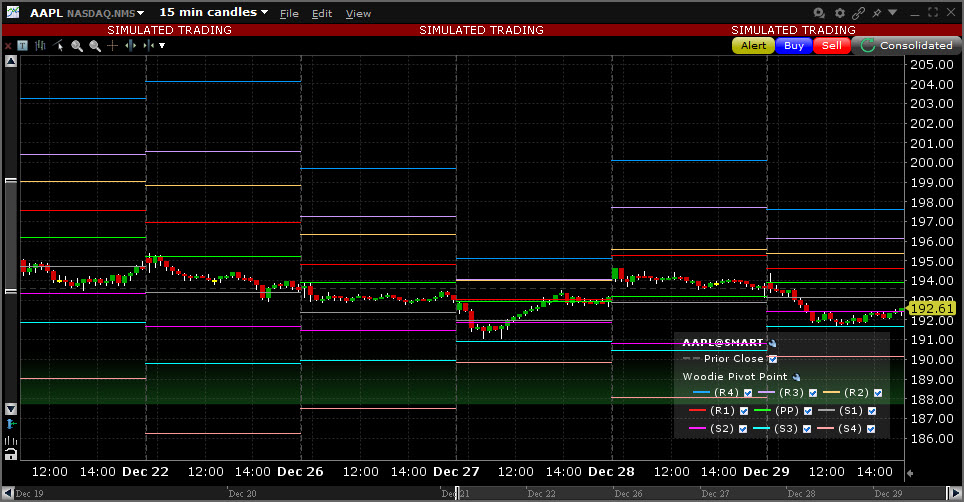
|
| Regression Studies | ||
| Awesome Oscillator | The Awesome Oscillator is an indicator used to measure market momentum. AO calculates the difference of a 34 Period and 5 Period Simple Moving Averages. The Simple Moving Averages that are used are not calculated using closing price but rather each bar's midpoints. AO is generally used to affirm trends or to anticipate possible reversals. |
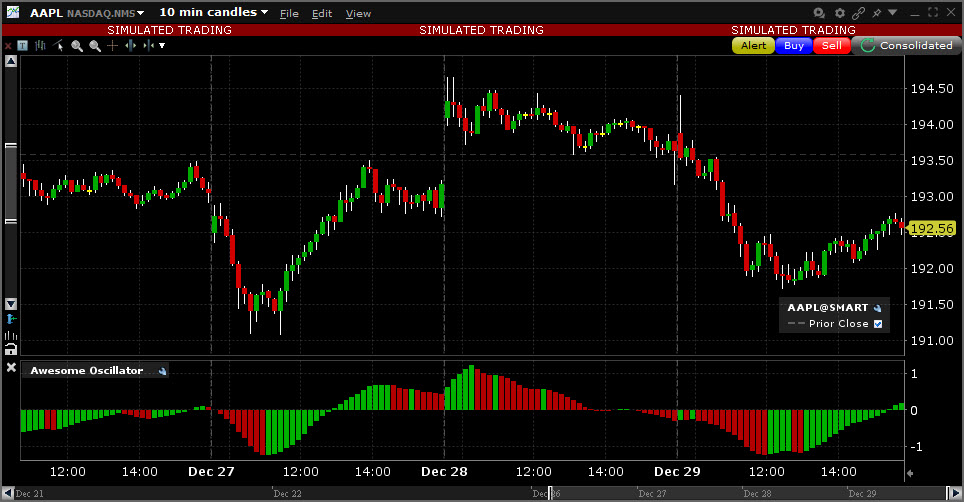
|
| Least Squares Moving Average | Sometimes called an End Point Moving Average, this indicator is based on a linear regression, but goes one step further by estimating what would happen if the regression line continued. Least Squares Moving Average is used mainly as a crossover signal with another moving average or with itself. |
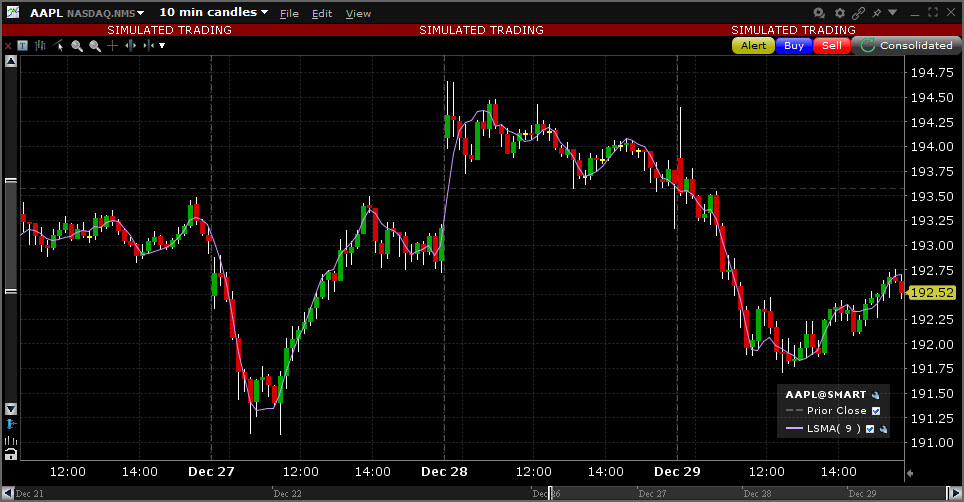
|
| Linear Regression (Least Square) | The Linear Regression Indicator is used for trend identification and trend following, similar to a moving average. The indicator should not be confused with Linear Regression Lines, which are straight lines fitted to a series of data points. The Linear Regression Indicator plots the end points of a whole series of linear regression lines drawn on consecutive days. The advantage of the Linear Regression Indicator over a normal moving average is that it has less lag than the moving average and responds more quickly to changes in direction. The downside is that it is more prone to whipsaws, where a price heads in one direction and then quickly moves in the opposite direction. |
.jpg)
|
| Linear Regression Curve | This indicator plots a line that best fits the prices specified over a user-defined time period. The Linear Regression Curve is used mainly to identify trend direction and is sometimes used to generate buy and sell signals. |
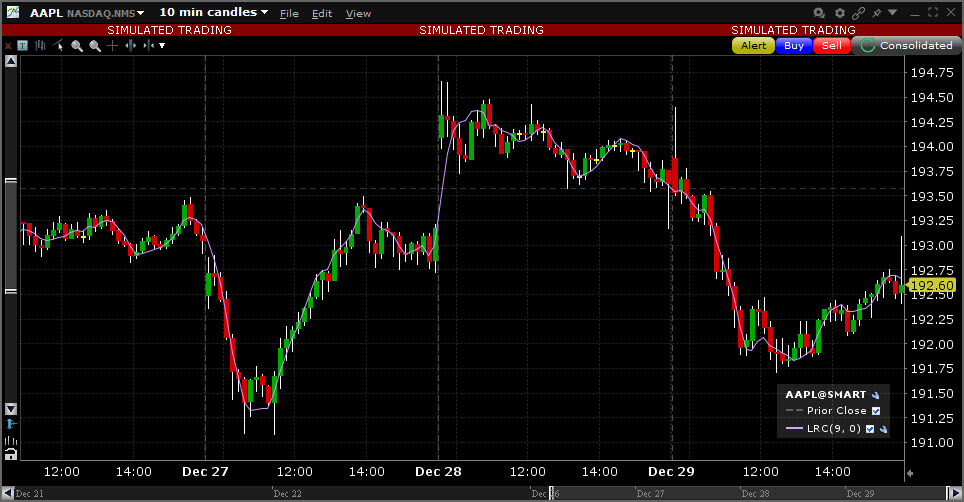
|
| Linear Regression Intercept | A statistical tool used to help predict future values from past values. It is commonly used as a quantitative way to determine the underlying trend and when prices are overextended. |
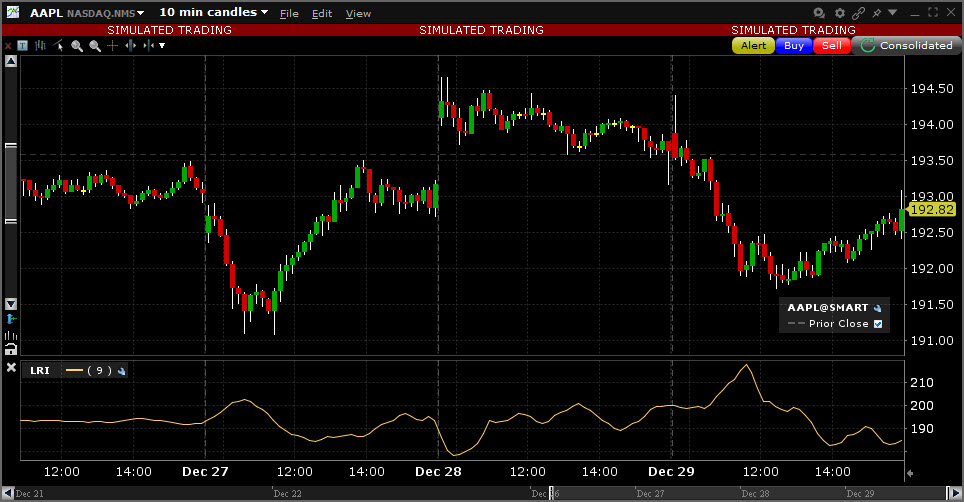
|
| Linear Regression R-Squared | An indicator used to determine the strength of the dominant market trend. It is typically used with other indicators such as Linear Regression Slope. The Slope indicates the overall market trend (positive or negative) and the R-Squared indicates the strength. |

|
| Linear Regression Slope | A common statistical technique used to identify the strength and direction of a dominant market trend. The Linear Regression Slope is a centered oscillator type of indicator similar to momentum indicators. As indicated by its name, it "oscillates" or fluctuates above and below a central line drawn at 0. In general, the momentum is positive when the slope is above 0 and negative when it is below 0. It can be used to measure the strength or weakness and direction of the momentum. |
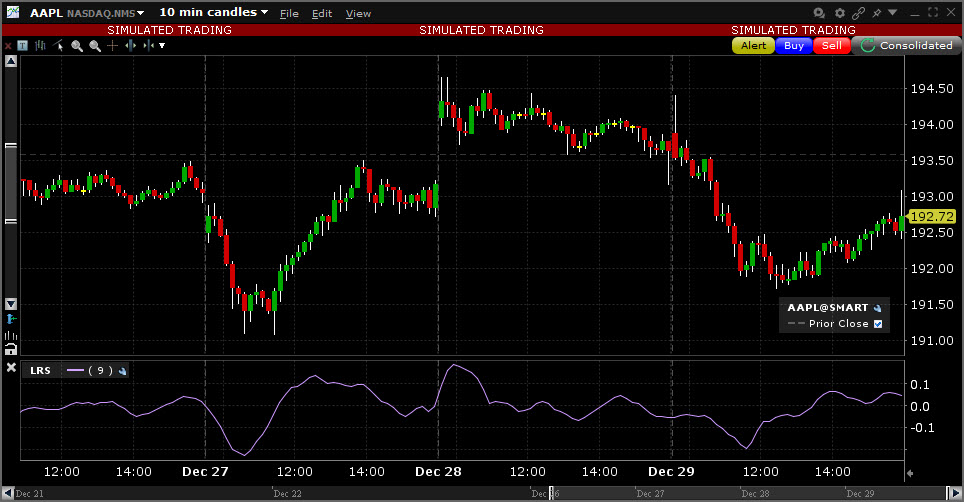
|
| Raff Channel | The Raff Channel is a linear regression with evenly spaced trend lines above and below. The width of the channel is based on the high or low that is the furthest from the linear regression. If prices continue to rise within the channel, the trend is up. An uptrend reverses when the price breaks below the channel extension. When prices decline within the channel, the trend is down. Similarly, a downtrend reverses when price the breaks above the channel extension. |
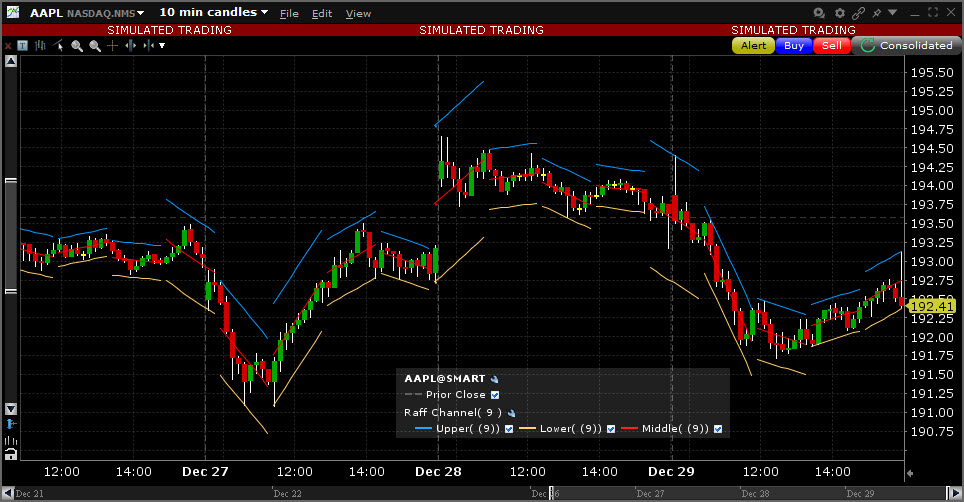
|
| Standard Deviation Channel | Standard deviation channels are plotted at a set number of standard deviations around a linear regression line. They can be used in swing trading and in detecting changes in momentum. |
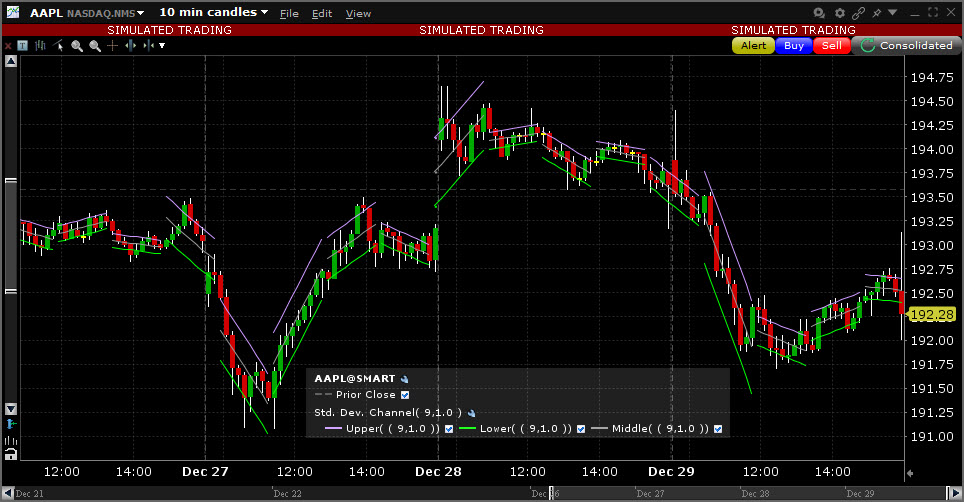
|
| Trend Studies | ||
| ADX/DMI |
The ADX/DMI is represented by three lines +DM, -DM and ADX. The Directional movement If today's High is higher than yesterday's High then: +DM = today's High - yesterday's High If today's Low is lower than yesterday's Low then: -DM = yesterday's Low - today's Low If +DM is greater than -DM then: -DM = 0 If +DM is less than -DM then: +DM = 0 The true range True range is the largest of:
Moving average of +DM, -DM and True Range
The Directional Indicators
Directional Index
The Average Directional Movement Index
Where: N — the number of periods used in the calculation. |

|
| ADXR | Quantifies a momentum change in the Average Directional Index (ADX). |
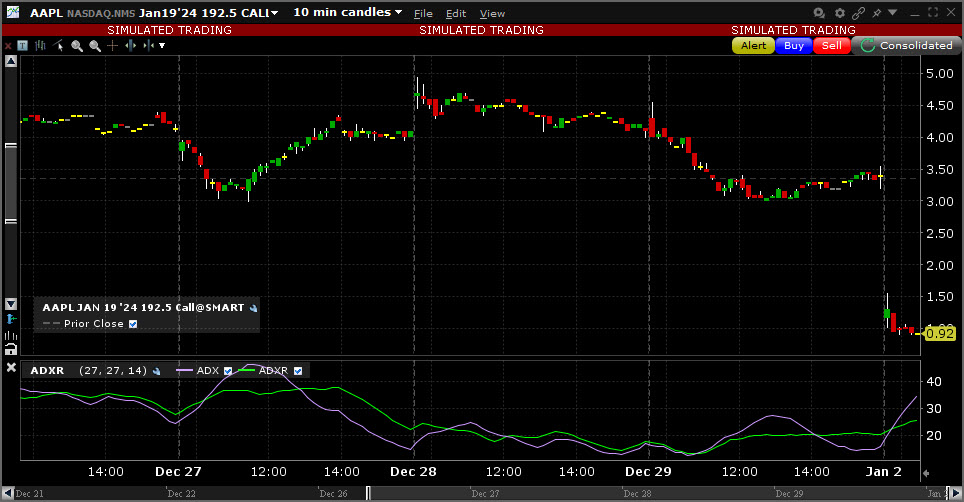
|
| Aroon Oscillator | A trend-following indicator that uses aspects of the Aroon indicator (see "Aroon Up/Down") to gauge the strength of a current trend and the likelihood that it will continue. The Aroon oscillator is calculated by subtracting Aroon down from Aroon up. Readings above zero indicate that an uptrend is present, while readings below zero indicate that a downtrend is present. |
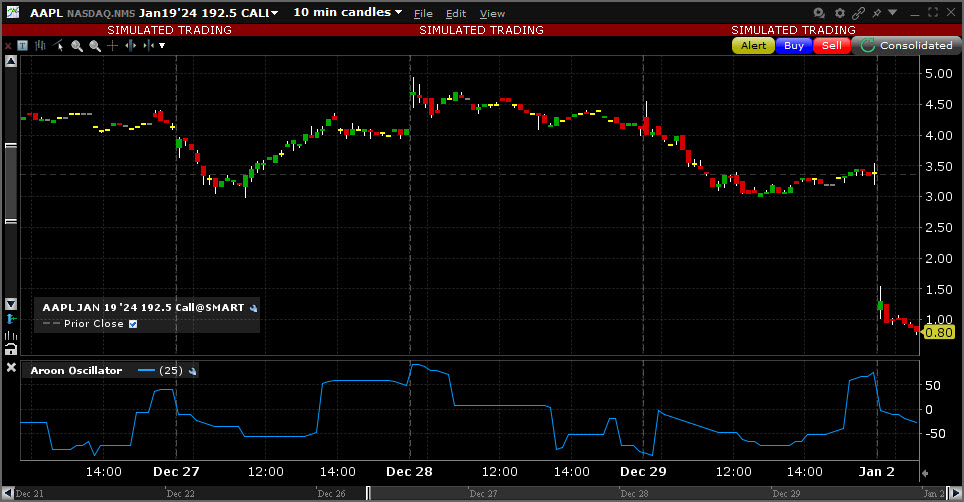
|
| Aroon Up/Dn | Aroon up” and “Aroon down” are the two components that comprise the Aroon indicator. Assuming that an asset is trending up when a stock is trading near the high of its range, Aroon up is used to measure the strength of the uptrend, while Aroon down is used to measure the strength of the downtrend. A cross above the zero line may suggest the beginning of a new uptrend. Conversely, a cross below zero could indicate the start of a downtrend. Readings near zero suggest that a security may be trending sideways and that this period of consolidation may continue. |
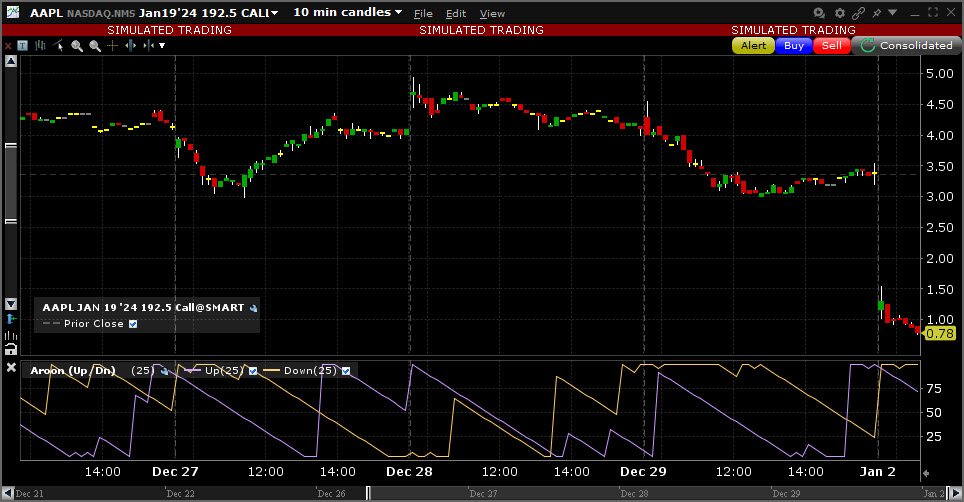
|
| Balance Of Power |
The Balance of Power indicator measures the market strength of buyers against sellers by assessing the ability of each side to drive prices to an extreme level. The calculation is: Balance of Power = (Close price – Open price) / (High price – Low price) The resulting value can be smoothed by a moving average. Traders may use this indicator to help:
|
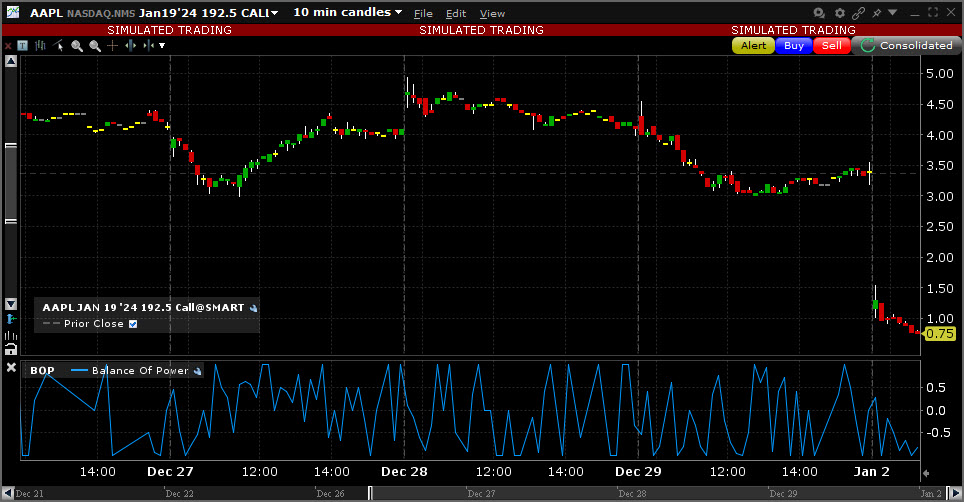
|
| Bill William's Alligator | The Alligator indicator comprises three moving average lines. The blue line represents the jaw, the red line represents the teeth, and the green line the lips. All of the moving average lines are editable and use the exponential moving average as the default. The interaction between the three lines helps identify trends. |
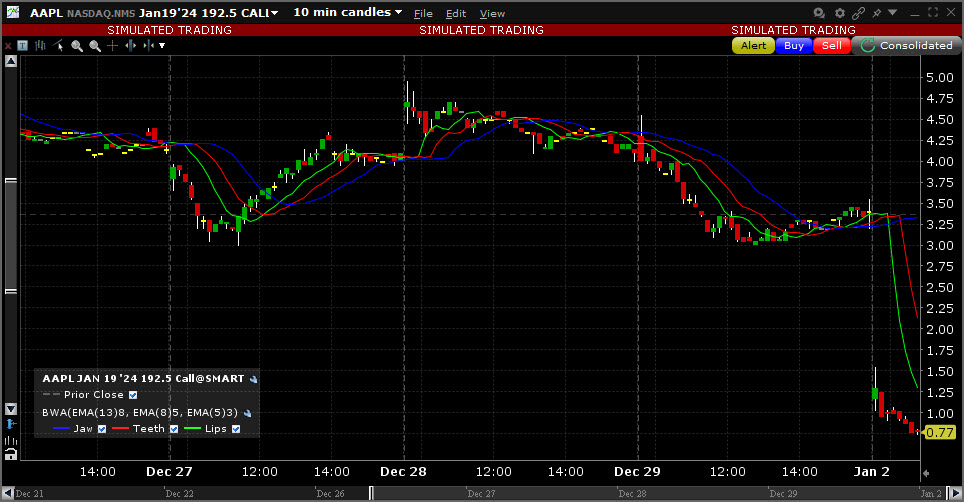
|
| Bill William's Alligator Oscillator | This indicator is displayed as a line chart in a plot separate from the Alligator. The Alligator Oscillator includes the same configurable fields as the Alligator plus a field to adjust the plot height of the indicator. |
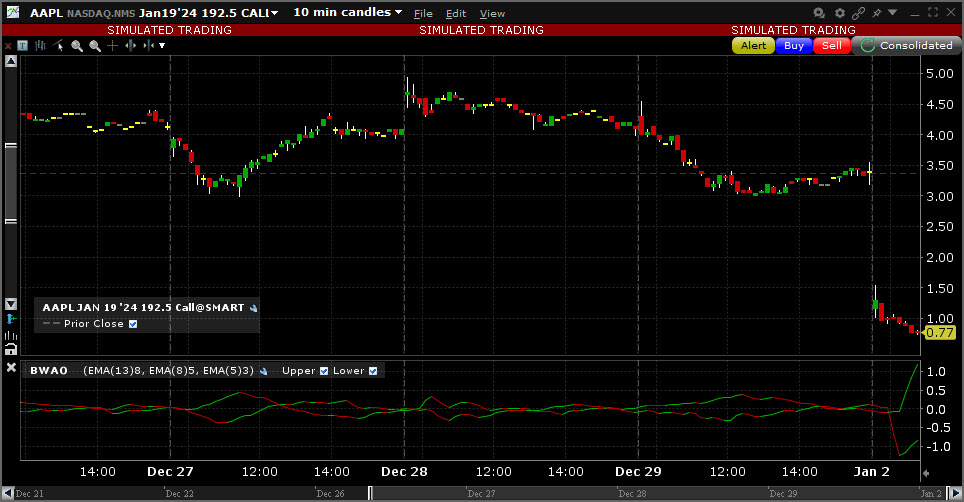
|
| Chande Kroll Stop |
This is a trend-following indicator that identifies the stop loss for a long or short position by using a variation on directional movement. It is calculated on the average true range of an instrument’s volatility. The stops are placed under (and on) the high (low) of the last “n” bars. The difference is proportional to the average True Range on “N” bars. You can use the Chande Kroll to trade in a number of ways:
As the price moves sideways you will note that the lines begin to flatten out and the price will trade broadly between the two lines. Make sure that when you trade it is always in the direction of the trend. |

|
| Chop Zone | This is a visual indicator designed to identify trends and choppiness. Plotted within -100/+100 levels, the Chop Zone illustrates the difference between close price and its EMA by converting its values to colors. |
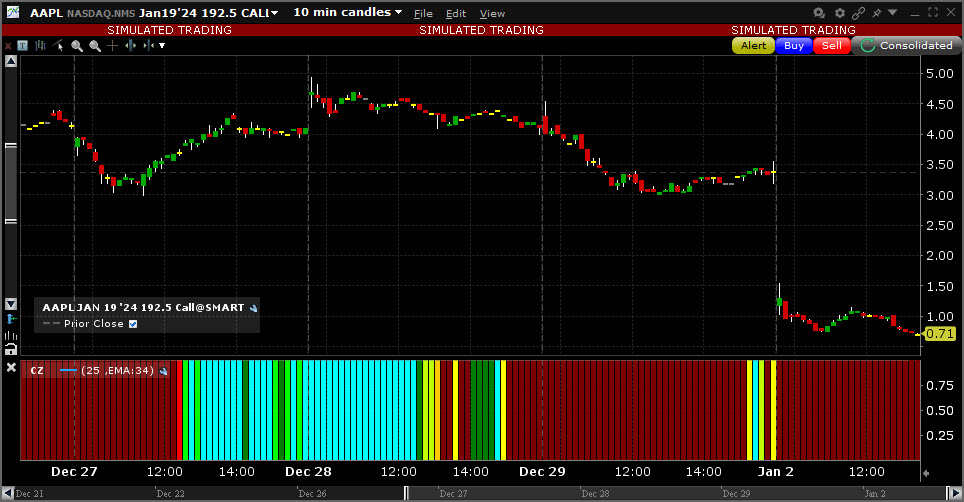
|
| Choppiness Index | The Choppiness Index is designed to determine whether the market is choppy or trading sideways, or not choppy and trading within a trend in either direction. Using a scale from 1 - 100, the market is considered to be choppy as values near 100 (over 61.80) and trending when values are lower than 38.20). |
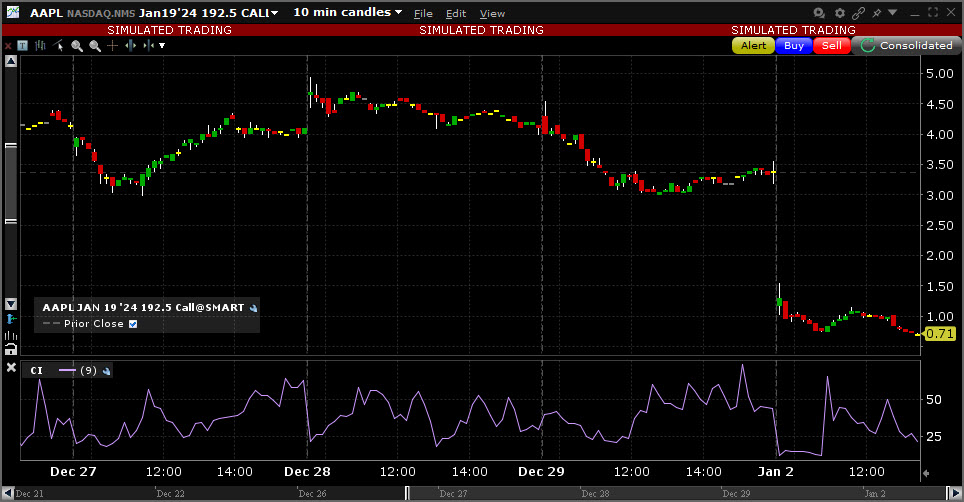
|
| Connors RSI | A three period RSI, the Connors RSI is a composite indicator consisting of three components. Two use the Relative Strength Index (RSI) calculations, and the third ranks the most recent price change on a scale of 0 to 100. Working together, these three factors form a momentum oscillator, an indicator that fluctuates between 0 and 100 to indicate the level to which a security is overbought (high values) or oversold (low values). |
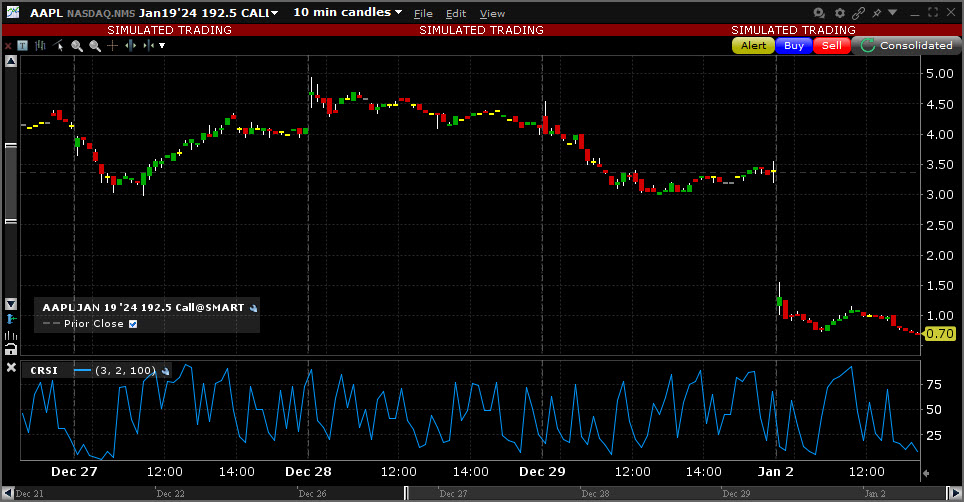
|
| Coppock Curve | The Coppock curve is a long-term price momentum indicator used primarily to recognize major bottoms in the stock market. It is considered to be an excellent tool for discriminating between bear market rallies and true bottoms in the stock market. The indicator was designed for use on a monthly time scale and is calculated as a 10-month weighted moving average of the sum of the 14-month rate of change and the 11-month rate of change for the index. A buy signal is generated when the indicator falls below zero and turns upward from a trough. Because the Coppock curve is a trend-following indicator, it does not pick an exact market bottom, but may identify rallies and reveal when a new bull market has begun. |
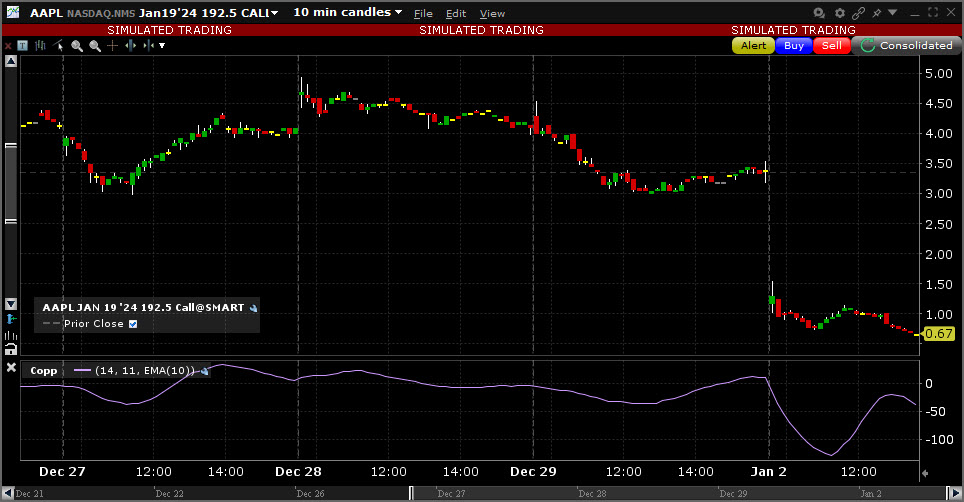
|
| DMI |
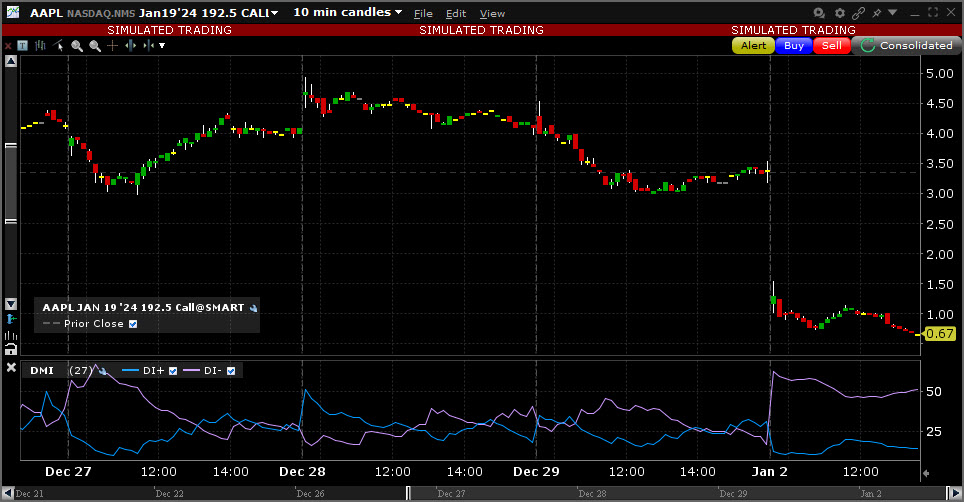
|
|
| Detrended Price Oscillator | This oscillator strips out price trends in an effort to estimate the length of price cycles from peak to peak, or trough to trough. Unlike other oscillators, such as the Stochastic or MACD, detrended price is not a momentum indicator. It highlights peaks and troughs in price, which are used to estimate entry and exit points in line with the historical cycle. |
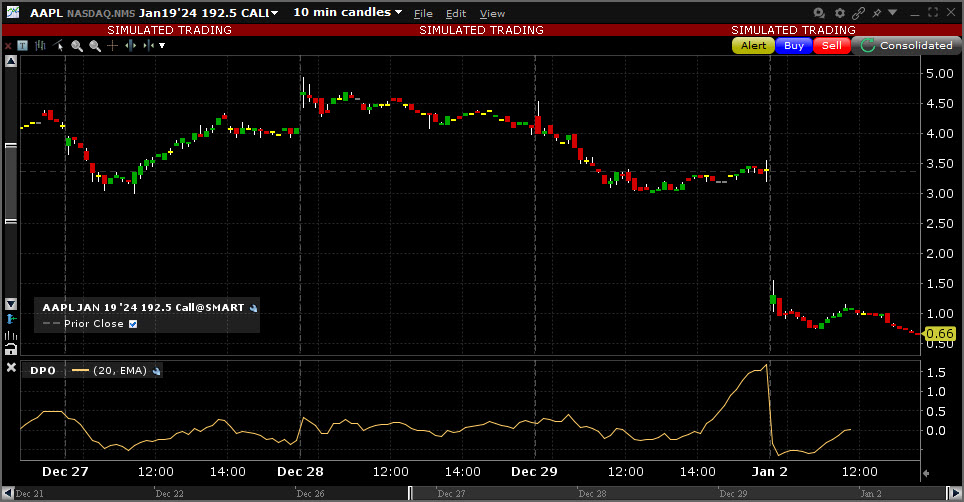
|
| Donchian Channel Width |
The width of Donchian Channels is a useful indicator for seeing the volatility of a market price. If a price is stable the Donchian channel will be relatively narrow. If the price fluctuates a lot the Donchian channel will be wider. This indicator is designed to detect trends: low values of the indicator signify that the price is moving sideways, while increasing values signify the start of a new trend. |
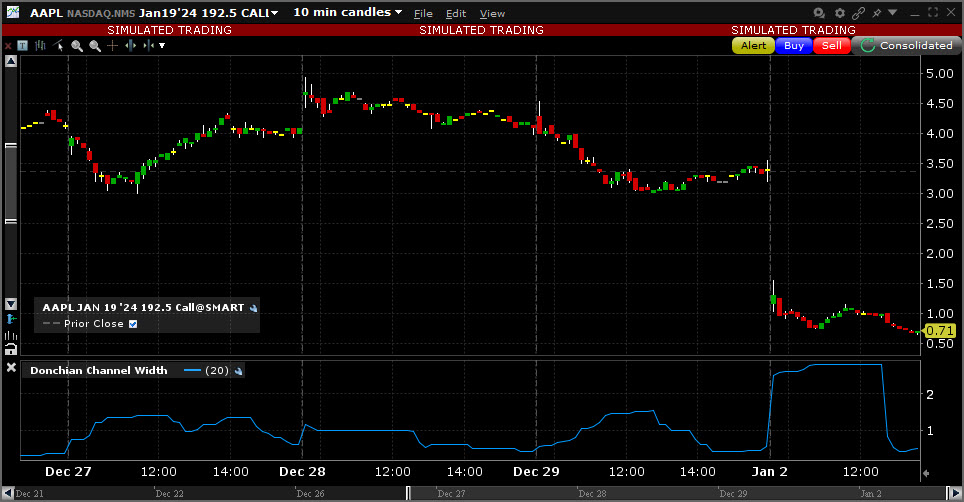
|
| Donchian Channels |
A simple trend-following breakout system, this moving average indicator that plots the highest high and lowest low over the last period time intervals. The signals derived from this system are based on the following basic rules:
|
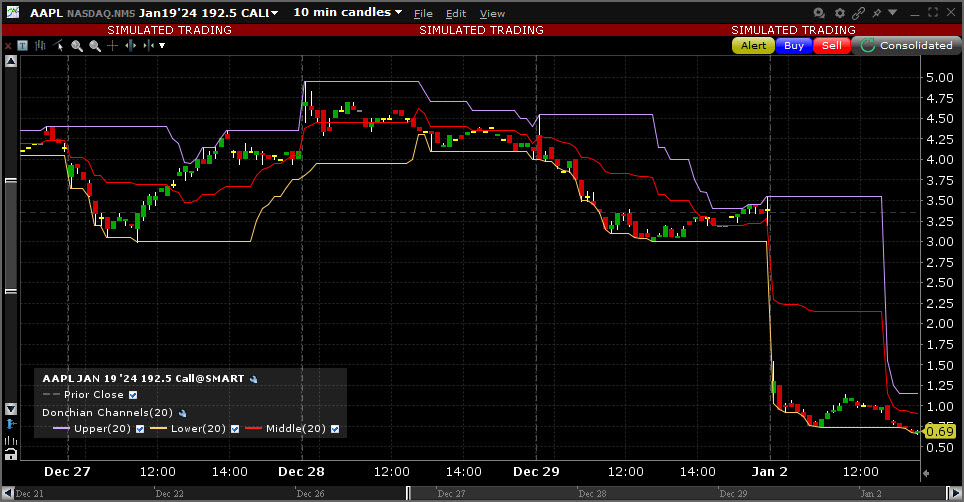
|
| Ergodic Oscillator | The Ergodic Oscillator (EO) is a double- smoothed True Strength Index (TSI) with a signal line. It acts like a stochastic indicator without the compression often seen with stochastics at extremes. As a result, the Ergodic helps to register long trends in prices. |
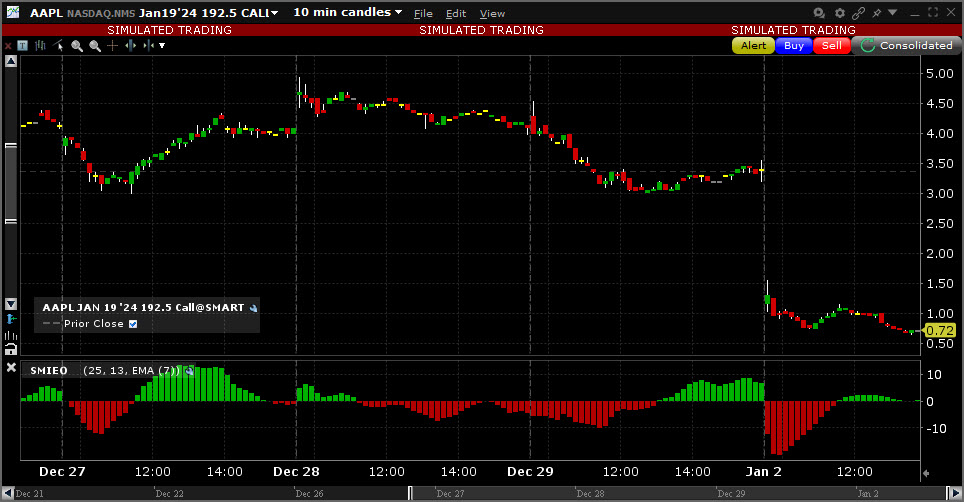
|
| Fisher Transform | Used to predict price reversals. The Fisher Transform helps to more clearly identify extreme price movements by transforming the probability density function of any waveform to a bell-curve. |
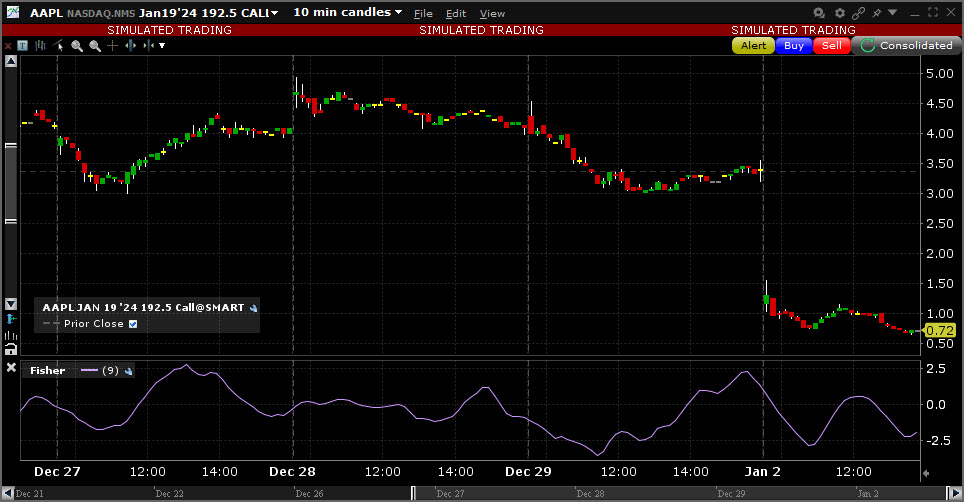
|
| High Low Bands | These two bands are generated from the triangular moving averages (calculated from the underlying price) and sandwich the underlying price. The triangular moving average is, in turn, shifted up and down by a fixed percentage. The bands are wave-lines formed by shifting the triangular moving average by some specific percentage on both the sides. Triangular moving averages are smooth in nature, which is why High Low bands tend to be more responsive to price fluctuations. They are most effective when it comes to trending markets, and may generate signals in trending markets. These bands, similar to all other indicators, fail in sideways or choppy markets. |
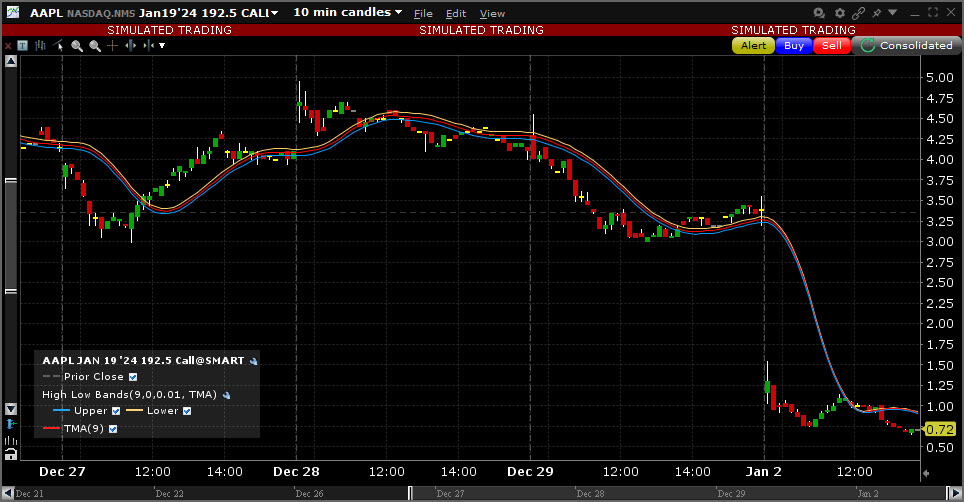
|
| Mass Index | This indicator examines the range between high and low stock prices over a specific period of time. It suggests that a reversal of the current trend will likely take place when the range widens beyond a certain point and then contracts. |

|
| Parabolic SAR |
For use in trending markets, parabolic SAR uses a trailing stop and reverse method to help determine good exit and entry points. The Parabolic SAR calculation is: SARt+1 = SARt+ AF x (EPtradex SARt) Where: SARt+1 — next period's SAR SARt - current SAR AF - acceleration factor, begins at .02 and increases by .02 to a maximum of 0.20. Note: You can reset the initial, increments and maximum acceleration factor when you create the study. EPtrade — the extreme price (HIGH for long positions and LOW for short positions). |
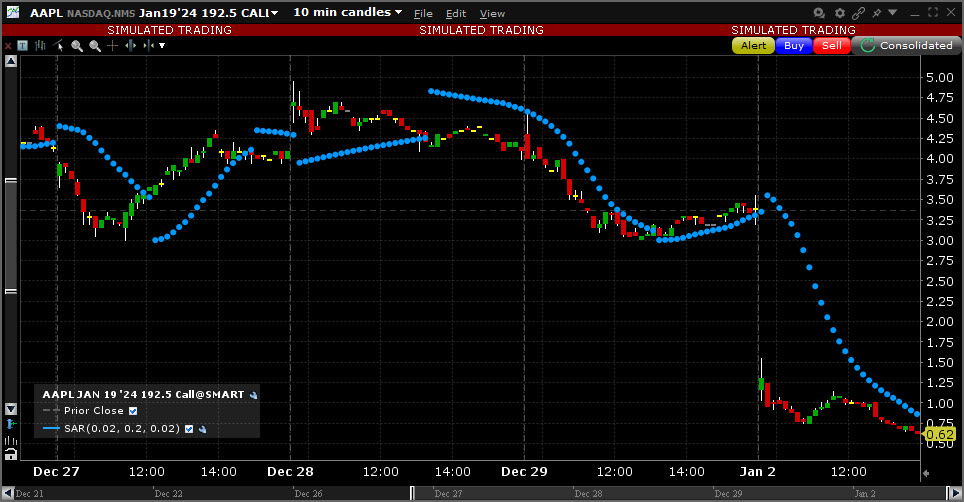
|
| Performance | The Performance indicator displays a security's price performance as a percentage. This is sometimes called a "normalized" chart. The Performance indicator displays the percentage that the security has increased since the first period displayed. For example, if the Performance indicator is 10, it means that the security's price has increased 10% since the first period displayed on the left side of the chart. Similarly, a value of -10% means that the security's price has fallen by 10% since the first period displayed. Performance charts are helpful for comparing the price movements of different securities. |
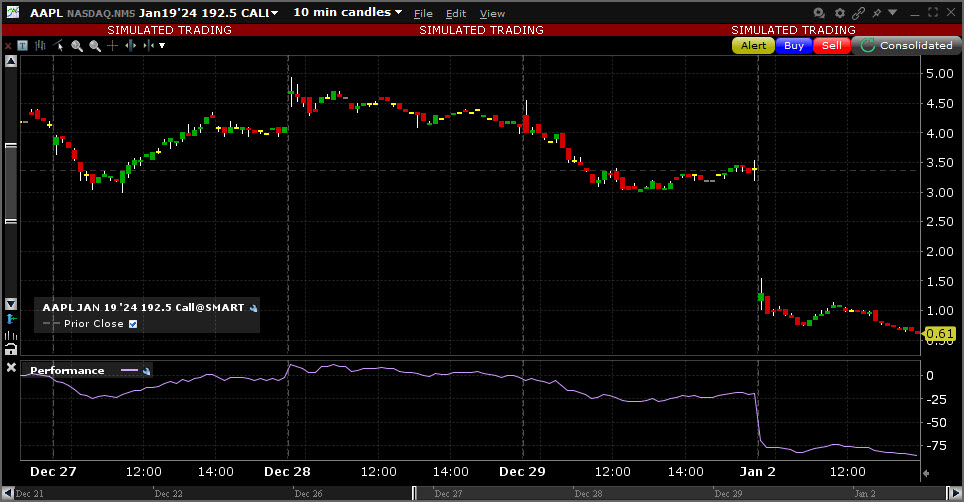
|
| Price Volume Trend | Price Volume Trend is a variation of On Balance Volume. It's a horizontal histogram that overlays the chart and helps determines the strength of trends and warn of reversals. |
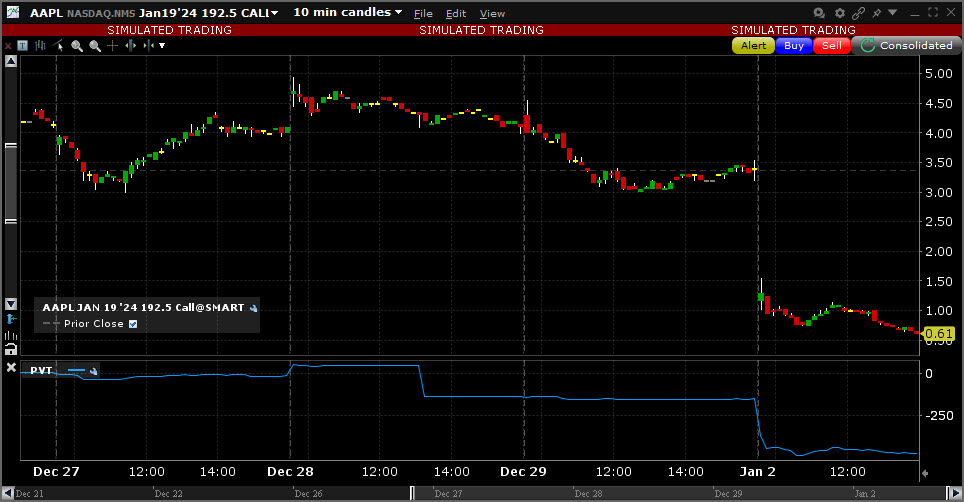
|
| Relative Vigor Index | The Relative Vigor Index measures the conviction of a recent price action and the likelihood that it will continue by comparing the positioning of a security's closing price relative to its price range. The result is smoothed by calculating an exponential moving average of the values. It's similar to the stochastic oscillator, but the vigor index compares the close relative to the open rather than relative to the low. The value will likely grow as the bullish trend gains momentum, since a security's closing price tends to be at the top of the range while the open is near the low of the day. |
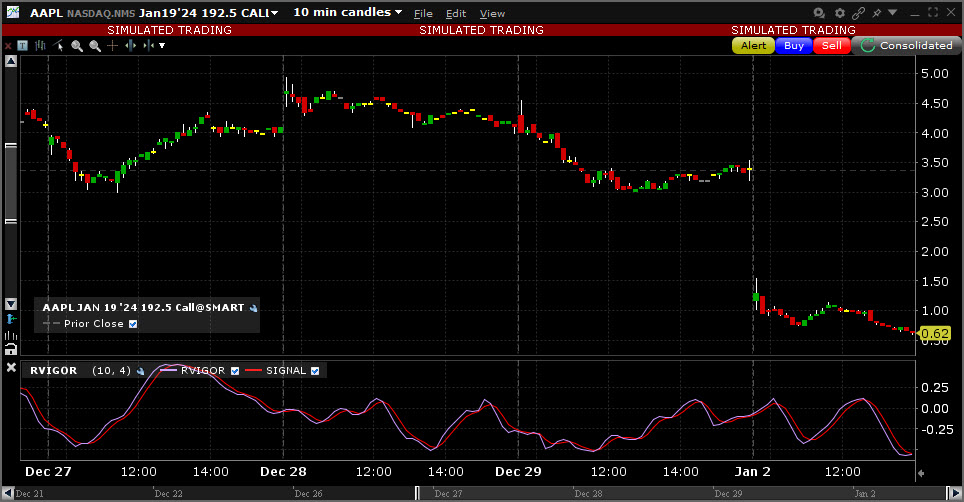
|
| Swing Index | The Swing Index tries to determine the real strength and direction of the market by comparing the relationships between the high, low and close prices of a stock. |
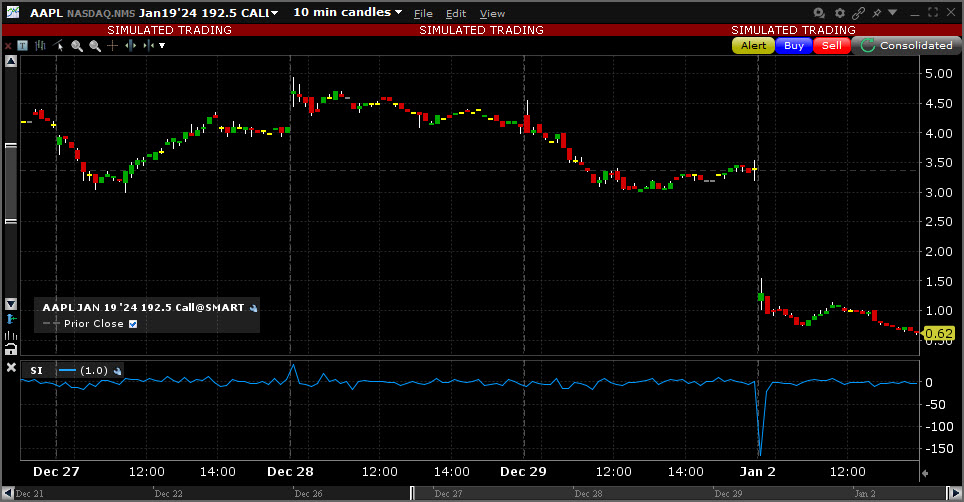
|
| Typical Price | Typical price, calculated as (High Low Close) / 3, is a useful filter for moving average systems. |

|
| Vertical Horizontal Filter | The Vertical Horizontal Filter determines whether prices are in a trending phase or a trading range or congestion phase. Trend-following indicators such as the MACD and moving averages are excellent in trending markets, but may generate multiple conflicting trades during trading range or congestion periods, while oscillators such as the RSI and stochastics work well when prices fluctuate within a trading range, but they almost always recommend closing positions prematurely during trending markets. The Vertical Horizontal Filter indicator attempts to determine the "trendiness" of prices to help a trader decide which of these indicator types to use. |
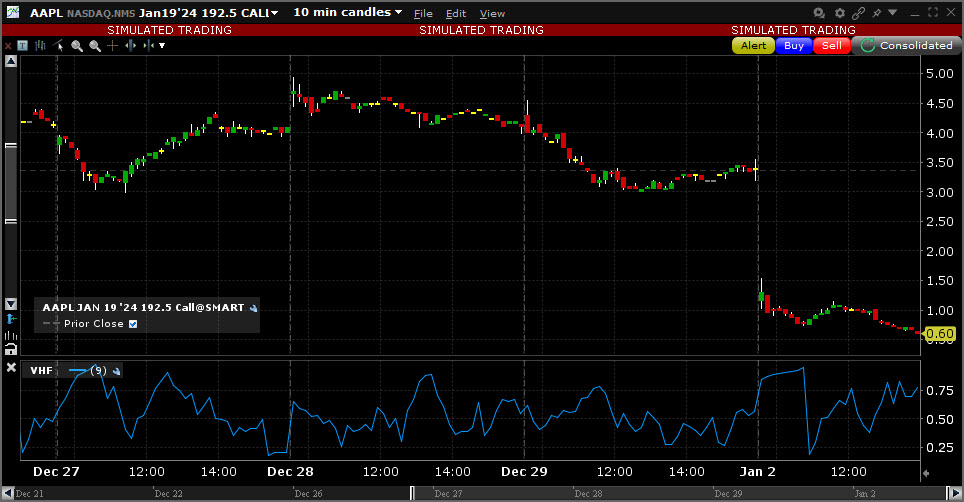
|
| Volatility Stop | The Volatility Stop Indicator helps define the current trend. This indicator plots a red line above the price bars when a downward trend is detected, and a blue line below the bars when an upward trend is detected. These lines are commonly used as trailing stops, and this indicator is commonly used as an exit tool rather than an entry technique. When price crosses the VSTOP value, the trend reverses and VSTOP moves to the other side of the price. |
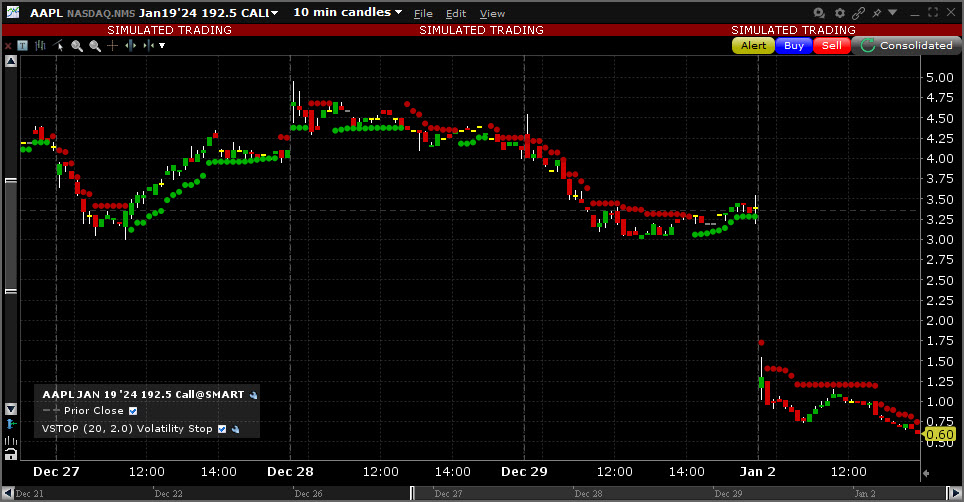
|
| Vortex | A two-line oscillator comprising an uptrend line (VI+) and a downtrend line (VI-). Used to spot trend reversals and confirm current trends. An uptrend or buy signal occurs when VI+ crosses above VI-. A downtrend or sell signal occurs when VI- crosses above VI+. |
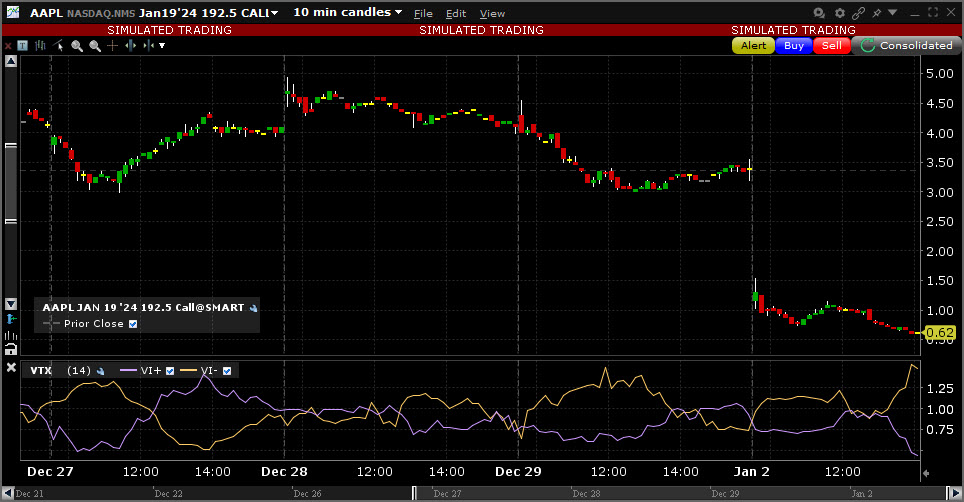
|
| Weighted Close | Presents an average of each day's price with extra weight given to the closing price. |
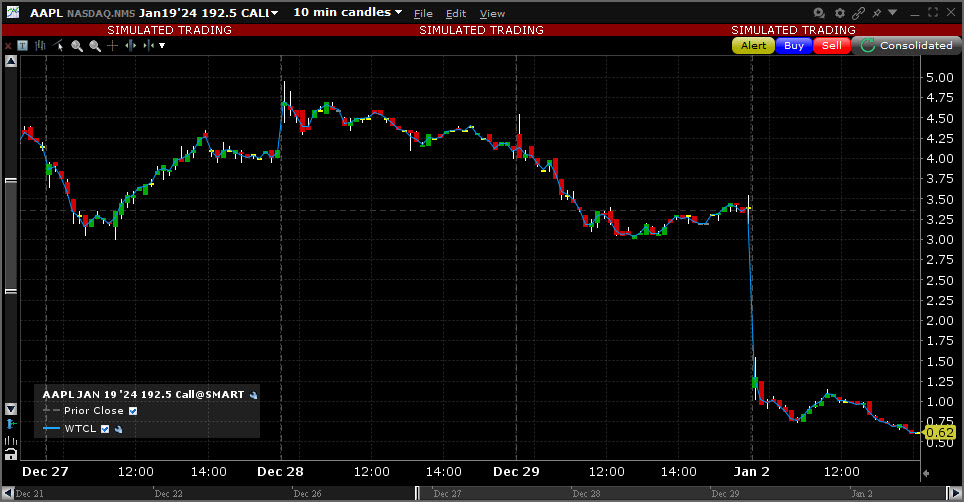
|
| Volatility Studies | ||
| Average True Range |
The Average True Range indicator is used to determine the volatility of the market. The idea is to replace the high-low interval for the given period, as the high-low does not take into consideration gaps and limit moves. You set the period when you create the study. The True Range is the largest of:
The Average True Range is a simple moving average of the true range values. |
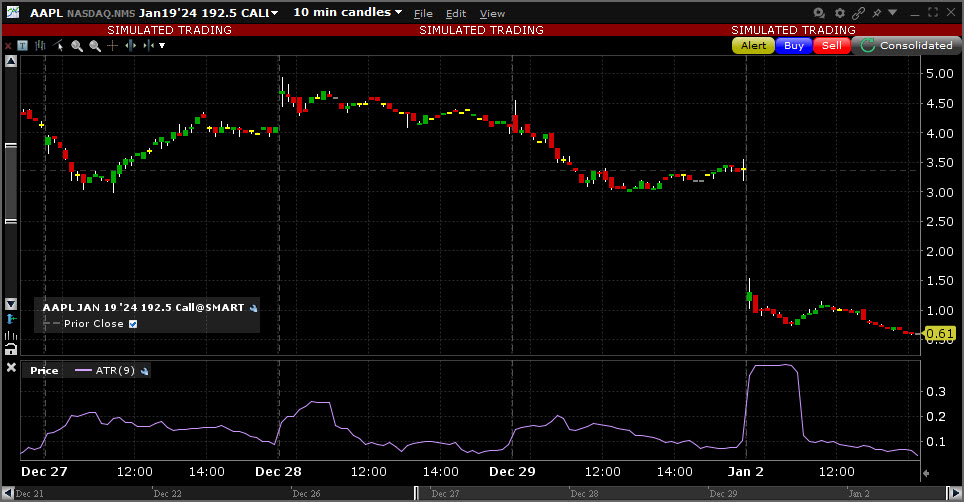
|
| Chaikin Volatility | Shows the difference between two moving averages of a volume-weighted accumulation-distribution line. Comparing the spread between a security's high and low price quantifies volatility as a widening of the range between the high and the low price. An increase in the Volatility Indicator over a relatively short time period may indicate that a bottom is near. A decrease in volatility over a longer time period may indicate an approaching top. It is recommended to use the Chaikin Volatility in conjunction with a moving average system or price envelope. |
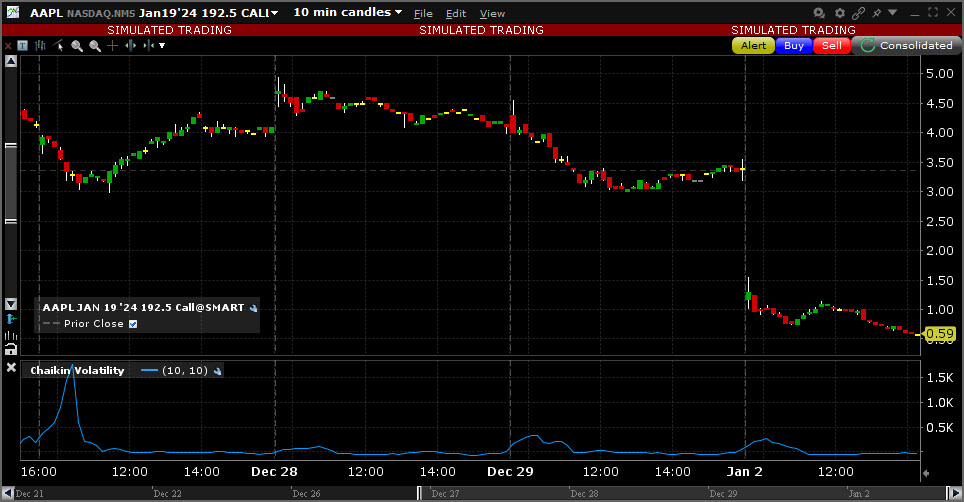
|
| Chande Volatility Index Dynamic Average | A moving average that automatically adjusts its speed based on market volatility. The absolute value of a 9-period Chande Momentum Oscillator is used for the volatility index. |
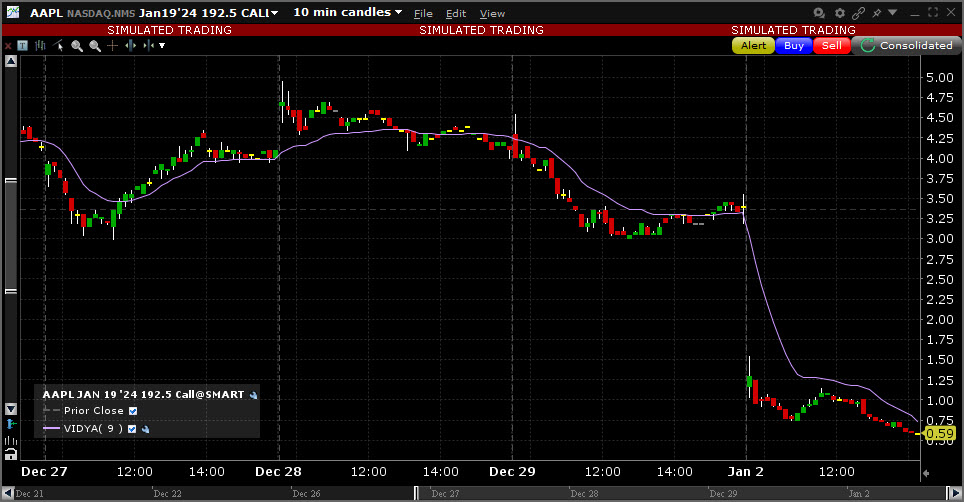
|
| Historical Volatility Ratio | The Historical Volatility Ratio is the percentage of short to long average historical volatility. When a market's short volatility declines below a certain percentage of its long volatility, it may be an indication that an explosive move is imminent |
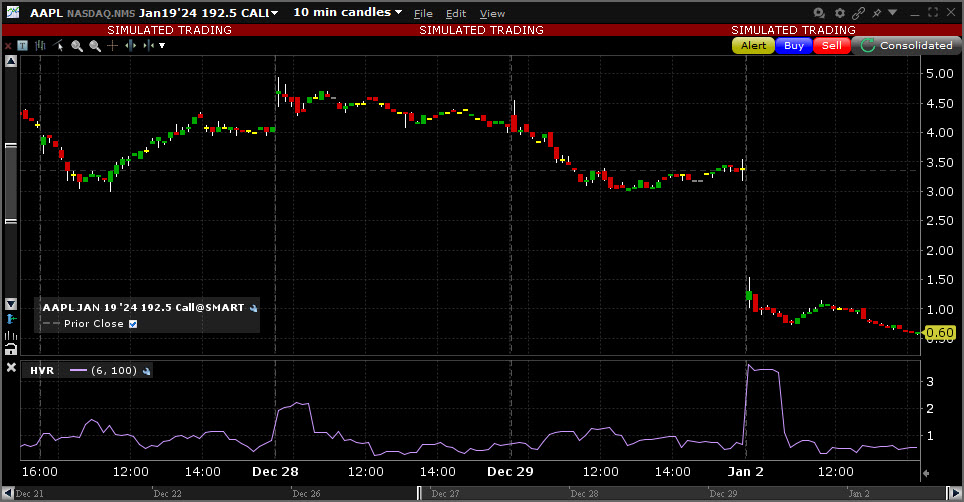
|
| Relative Volatility Index | The Relative Volatility Index (RVI) is similar to the Relative Strength Index (RSI) index. Both measure the direction of volatility, but RVI uses the standard deviation of price changes in its calculations, while RSI uses the absolute price changes. The RVI is best used as a confirmation indicator to other momentum and/or trend-following indicators. |
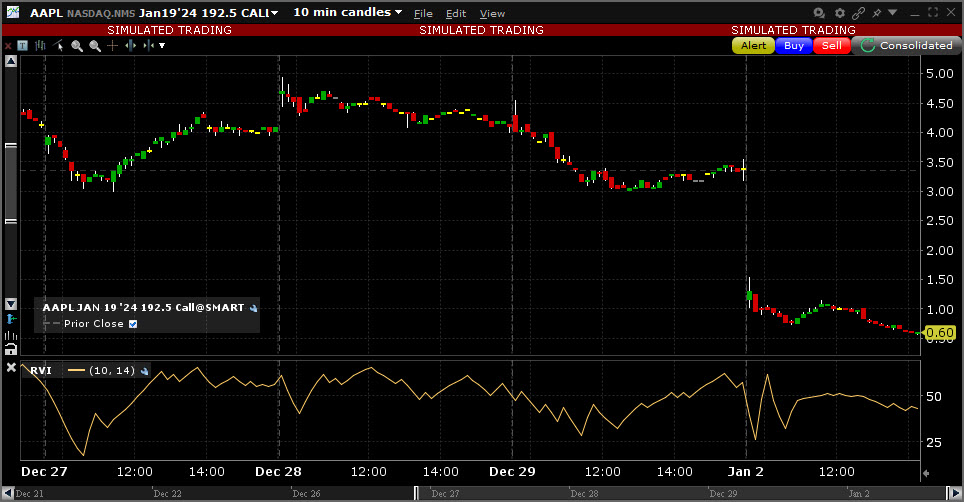
|
| Volume Studies | ||
| Intraday Volume Weighted Average Price |
Tracks VWAP throughout the day, and displays as a colored line linking VWAP values at varying times throughout the one-day period. By default, the line that tracks Intraday VWAP is bracketed within a high/low standard deviation range. The standard deviation is calculated for the same period as the VWAP, and the range can be adjusted by modifying the number of Standard Deviations within the settings of the Intraday VWAP. Intraday VWAP is calculated as: VWAP=[sum (Volume_bar_i * Typical_price_i)]/sum(volume_bar_i) where i is the intraday bar number. If we use a 1 min daily bar chart, the calculation is made from the first minute with i=[1;N] where N is the last bar number of the chart, Typical_price_i = VWAP_on_bar_price_i => This is the VWAP we currently store and volume_bar_i is the volume for the bar i. If no volume is available for the product (i.e. for IND, CASH and CMDY), use 1 as volume for each bar. |
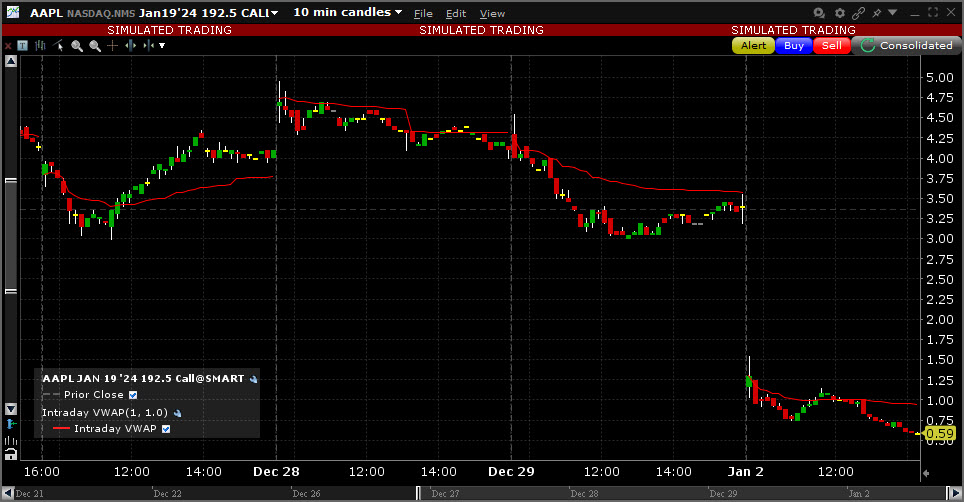
|
| Klinger Volume Oscillator | This oscillator is used to determine long-term trends of money flow, while remaining sensitive enough to short-term fluctuations to predict short-term reversals. It compares the volume flowing in and out of a security to price movement, and it is then turned into an oscillator. A signal line (13-period moving average) is used to trigger transaction decisions. This technique is very similar to signals that are created with other indicators such as the MACD (moving average convergence divergence). The Klinger Oscillator also uses divergence to identify when price and volume are not confirming the direction of the move. It is considered to be a bullish sign when the value of the indicator is heading upward while the price of the security continues to fall. It is recommended to use other tools such as trendlines, moving averages and other indicators to confirm the reversal. |
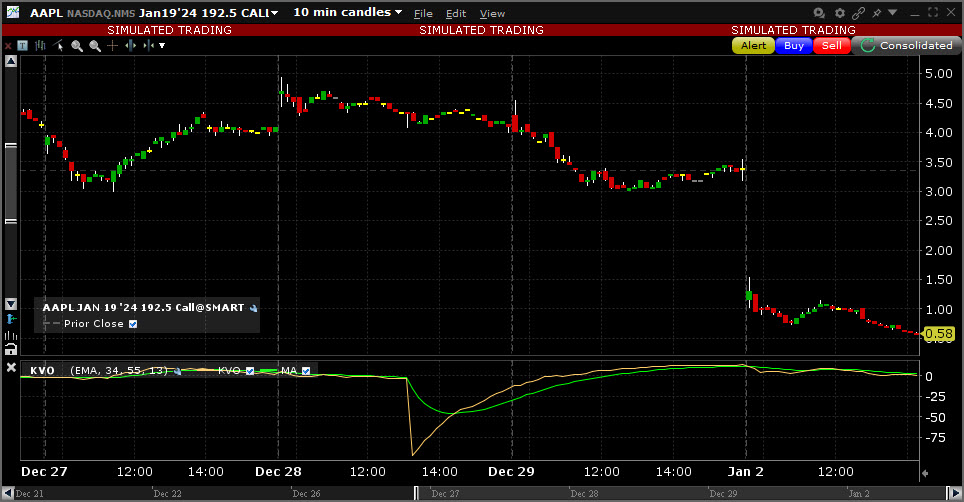
|
| Moving Volume Weighted Average Price | Identical to our existing Weighted Moving Average indicator except that it uses volume data instead of price data. |
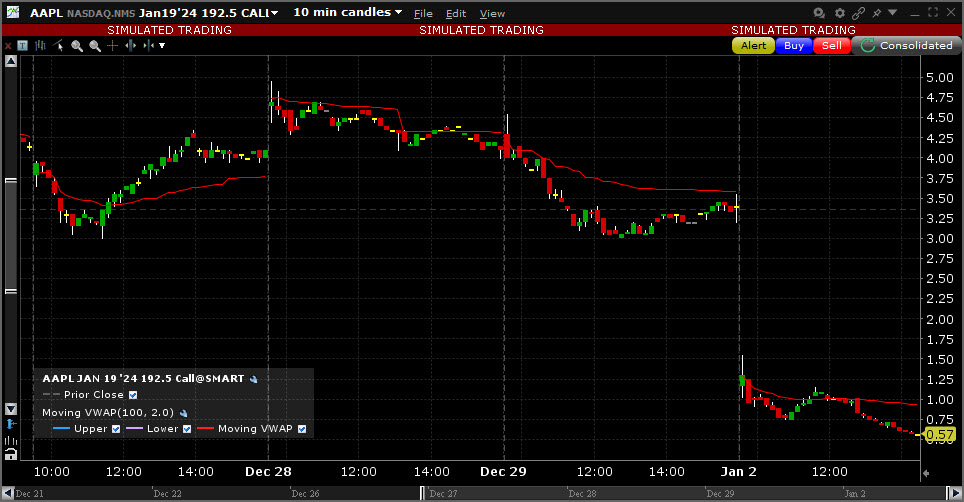
|
| Negative Volume Index | This indicator relies on changes in a security’s volume to identify when so-called “smart money” (i.e. institutions, funds and professional traders) is driving the current trend. The Negative Volume Index suggests that unsophisticated investors buy and sell primarily on high-volume days, while shrewd investors are more likely to trade on low-volume days. Often when volume drops, price drops. If a stock’s price increases despite a decrease in volume, technical analysts consider this a positive sign. They use the negative volume index to help identify bull and bear markets. |
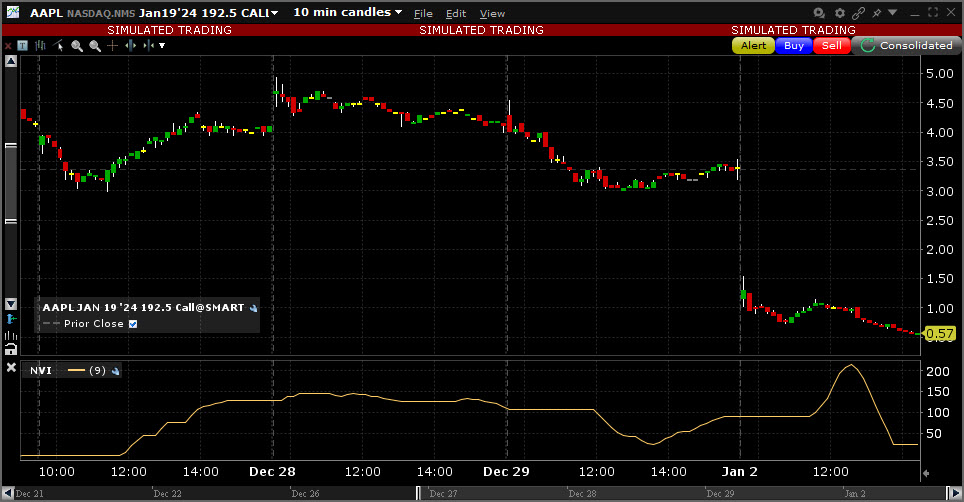
|
| Net Volume | A security's uptick volume minus its downtick volume over a specified time period. The net volume of a stock aggregates the total positive and negative movements of the security over this period. When the total upward movement is greater than the total downward movement over this period, the stock has a positive net volume. |
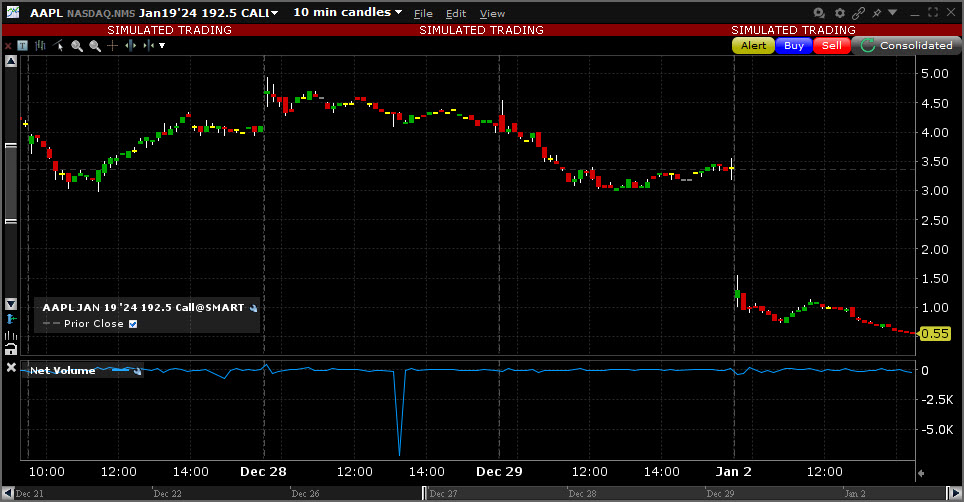
|
| On Balance Volume |
The concept behind the OBV indicator is: volume precedes price. OBV is a simple indicator that adds a period's volume when the close is up and subtracts the period's volume when the close is down. A cumulative total of the volume additions and subtractions forms the OBV line. If today’s close is greater than yesterday’s close then: OBV(i) = OBV(i-1)+VOLUME(i) If today’s close is less than yesterday’s close then: OBV(i) = OBV(i-1)-VOLUME(i) If today’s close is equal to yesterday’s close then: OBV(i) = OBV(i-1) Where: OBV(i) — is the indicator value of the current period. OBV(i-1) — is the indicator value of the previous period. VOLUME(i) — is the volume of the current bar. |
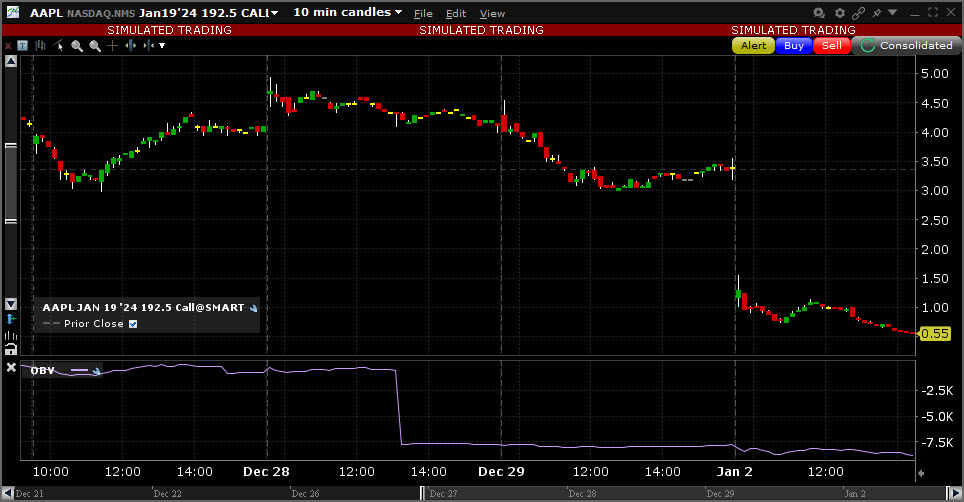
|
| Percentage Volume Oscillator | A momentum oscillator for volume. It measures the difference between two volume-based moving averages as a percentage of the larger moving average. |
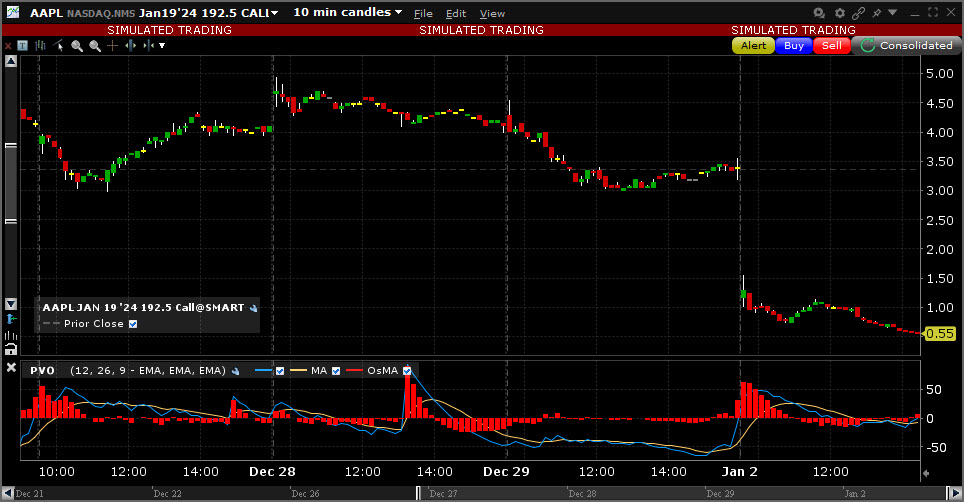
|
| Positive Volume Index |
An indicator used in technical analysis that is based on days where trading volume has significantly increased from the previous day. The Positive Volume Index (PVI) assumes that uninformed investors dominate the action on days with substantial trading volume, while the "smart money" - consisting of institutions, funds and professional traders - is more active on relatively quiet days with below-average trading volume. As the PVI only takes into consideration days when trading volume is higher compared with the previous period, if the PVI is up, it implies that price is appreciating on rising volume, while a lower PVI implies that price is declining on rising volume. |
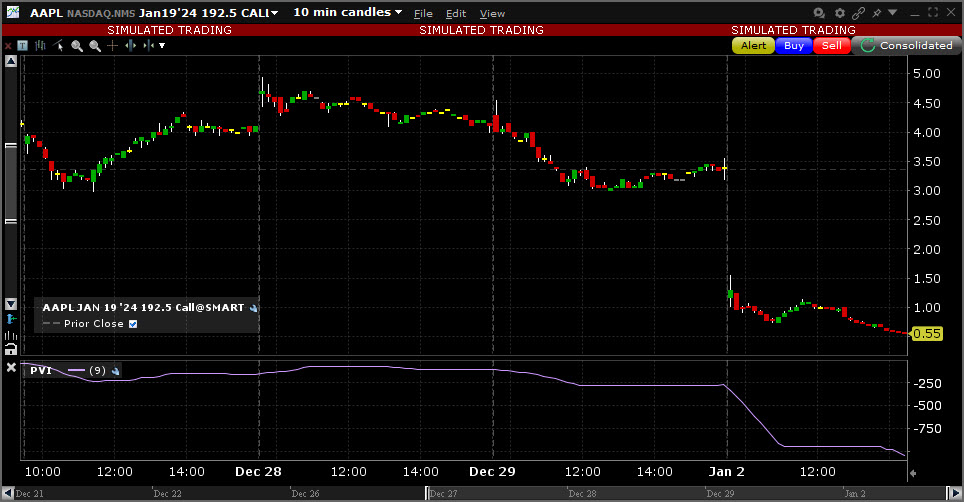
|
| Volume * PMO | A price and volume momentum oscillator. Traders might consider buying when the VPMO rises above zero and selling when it falls below. |

|
| Volume Exponential Moving Average | Identical to our existing Exponential Moving Average indicator except that it uses volume data instead of price data. |
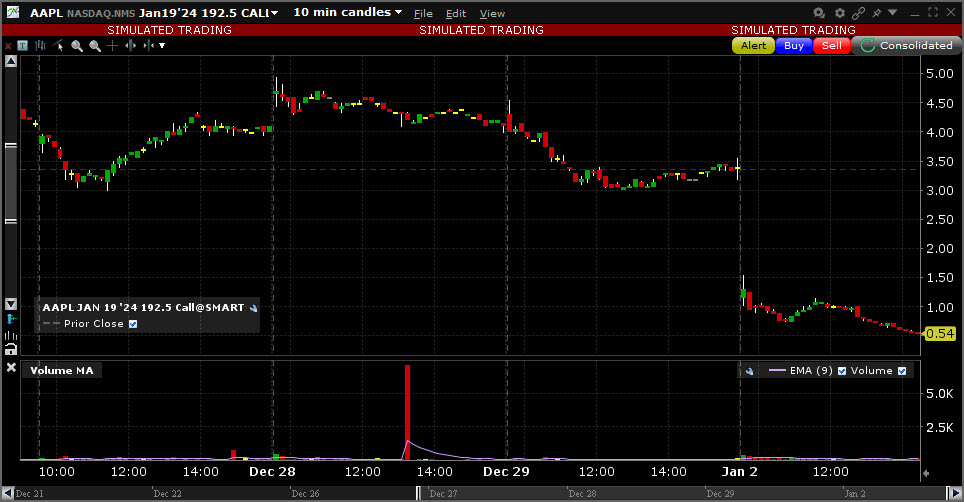
|
| Volume Oscillator | Measures volume by measuring the relationship between two moving averages. |
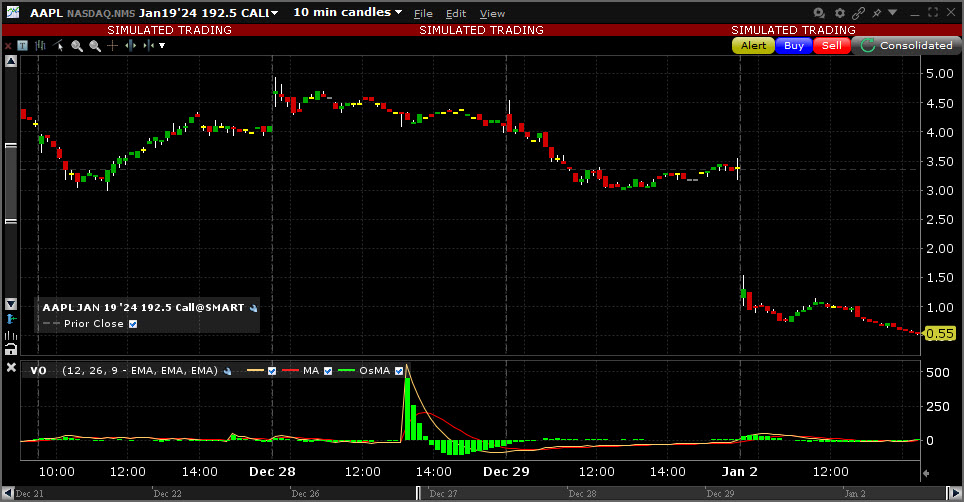
|
| Volume Rate of Change | The volume rate of change indicator is used to gauge the volatility in a security’s volume. The volume rate of change is a powerful indicator when estimating a security’s ability to push through key resistance. It is calculated the exact same way as the rate of change indicator except instead of tracking the closing price it tracks volume. The calculation is: Volume ROC = ((Volume – Volume n-periods ago )/ Volume n-periods ago) *100. |
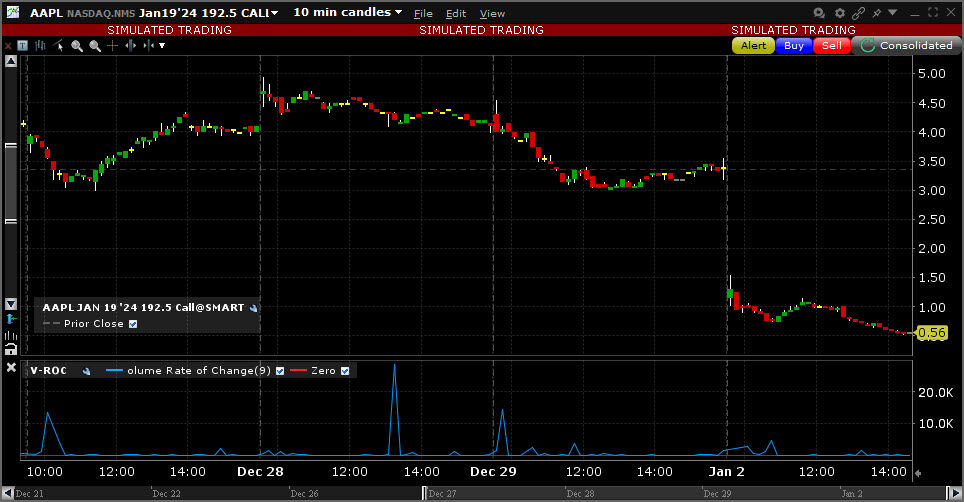
|
| Volume Simple Moving Average |
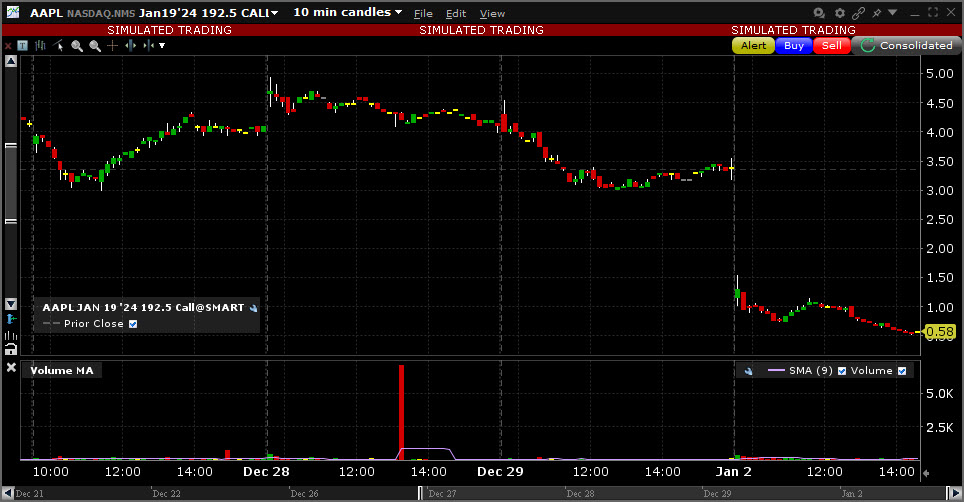
|
|
| Volume Weighted Moving Average | Identical to our existing Weighted Moving Average indicator except that it uses volume data instead of price data. |
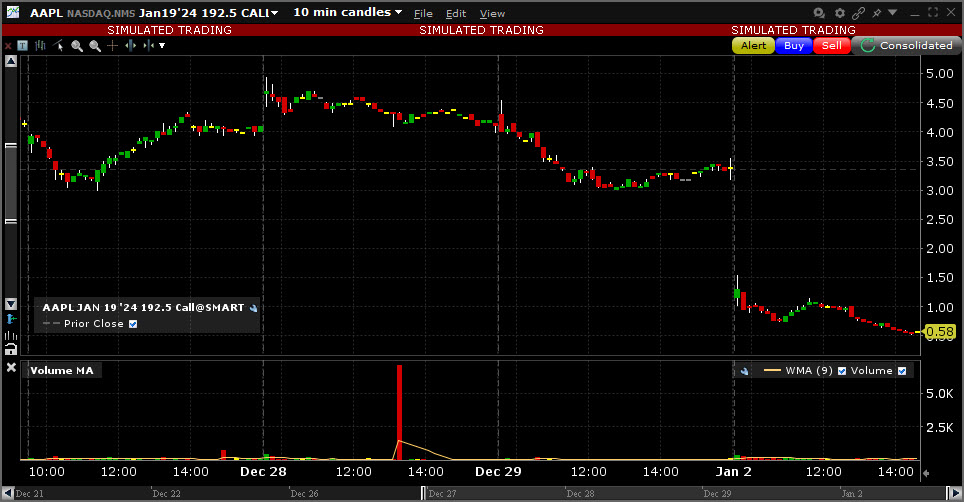
|
| Licensed - SimplerOptions/John Carter | ||
| Combo Wave | ||
| Porsche Dots | ||
| Probability Zones | ||
| Rolling Weekly Pivots | ||
| TTM Squeeze | ||
| Wave A | ||
| Wave B | ||
| Wave C | ||
Additional Resources
Learn About Chart Indicators in Trader Workstation at IBKR Campus